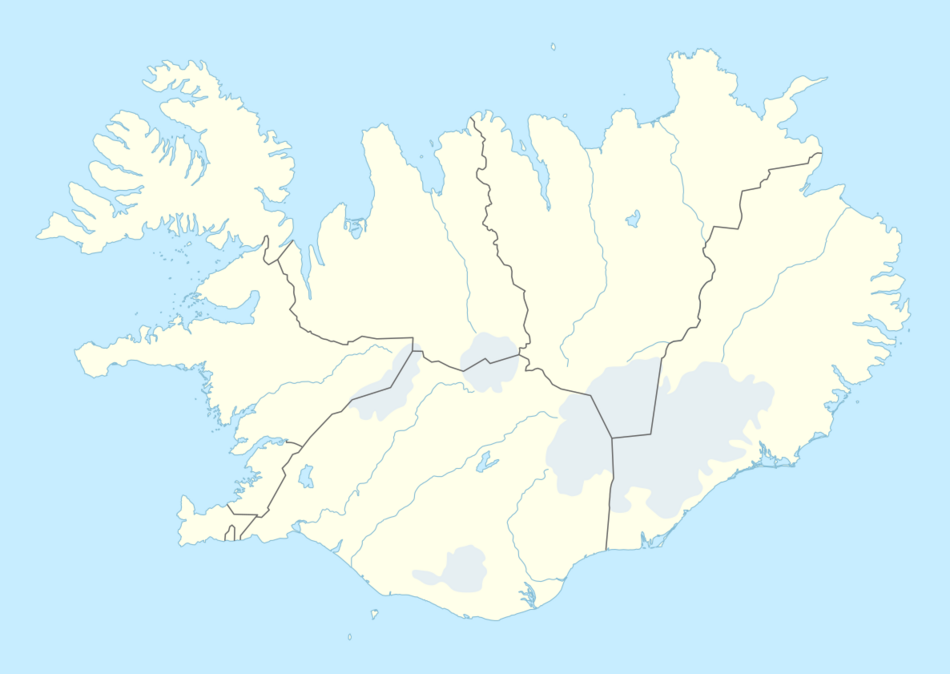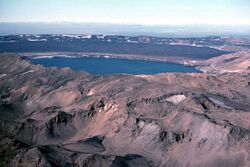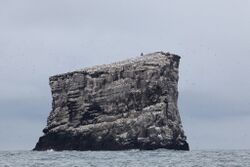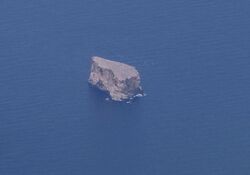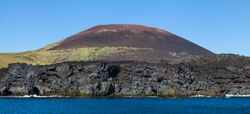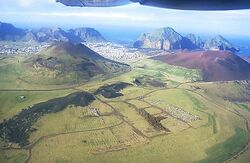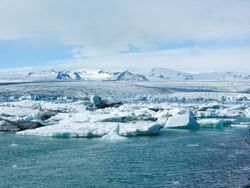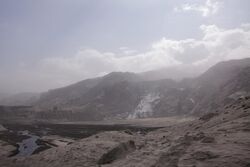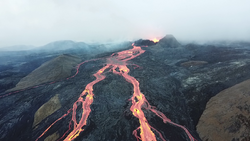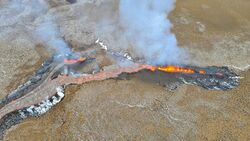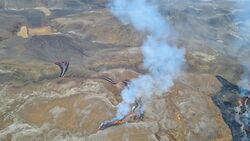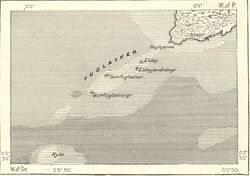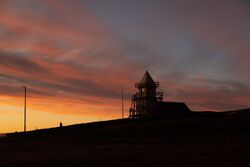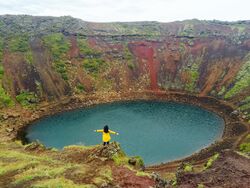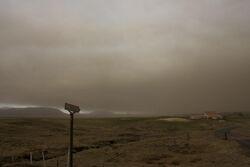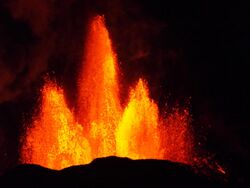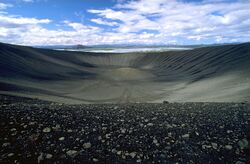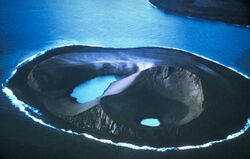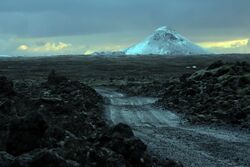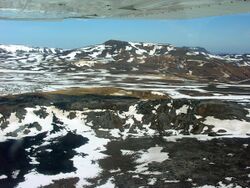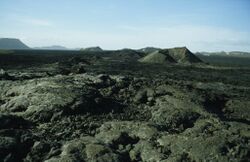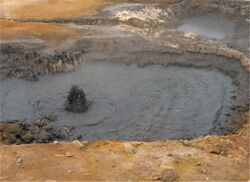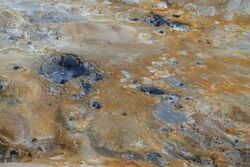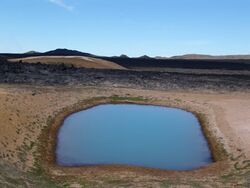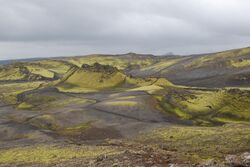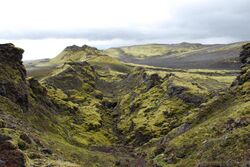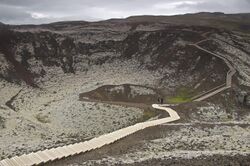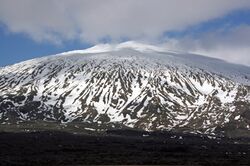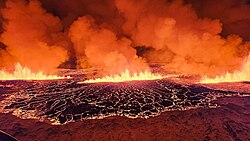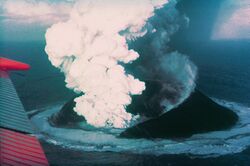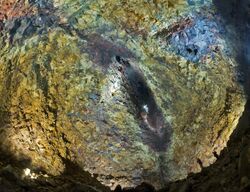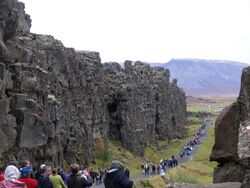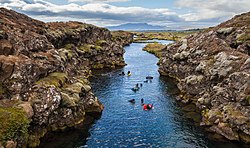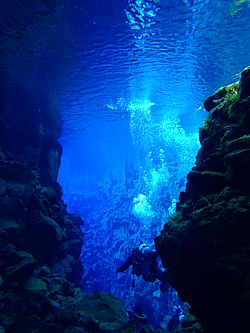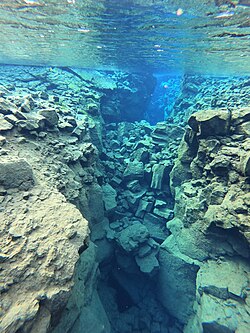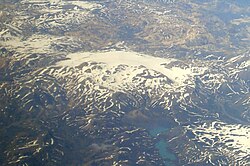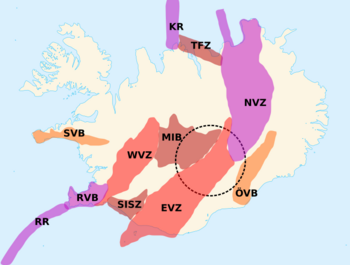List of volcanic eruptions in Iceland
Topic: Organization
 From HandWiki - Reading time: 61 min
From HandWiki - Reading time: 61 min
This is an incomplete list of volcanic eruptions in Iceland.
Index map of eruptions, fissures, glaciers and notable sites
Alphabetic index of eruptions, fissures and notable sites

See "Askja index"

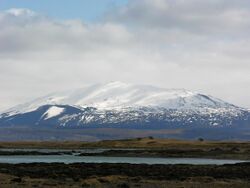
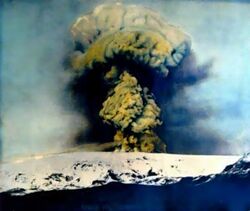

(See Thríhnákagígur index)
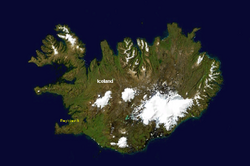
There are about 32 volcanic systems in Iceland. Volcanic system means a volcano-tectonic fissure system and – very often a bigger volcano, a so-called central volcano which in most cases is a stratovolcano and may contain a caldera.[2][3]
Askja
- Askja; An active volcano in the central highlands. A complex of nested calderas within the Dyngjufjöll mountains. The Askja system includes, for example, the Herðubreið tabular volcano, the Herðubreiðartögl palagonite ridge and the shield volcanoes Kollóttadyngja, Flatadyngja and Svartadyngja. (Part of the North volcanic zone (NVZ)).
See chronology below: Askja 11,000, Askja 1874, Askja 1875-January, Askja 1875-February, Askja 1875-March, Askja 1876, Askja 1921, Askja 1922, Askja 1923, Askja 1926, Askja 1929, Askja 1961.
Bárðarbunga
- Bárðarbunga; An active stratovolcano located under the Vatnajökull glacier. The second highest mountain in Iceland, 2,009 metres (6,591 ft) above sea level, and part of a volcanic system that is approximately 200 kilometres (120 mi) long and 25 kilometres (16 mi) wide. Historically there are large eruptions every 250–600 years. Part of the East volcanic zone (EVZ).
See chronology below: Bárðarbunga ca.6600-6700 BC, Bárðarbunga 870, Bárðarbunga 1477, Bárðarbunga 1701-1864, Bárðarbunga 1910, Bárðarbunga 1996, Bárðarbunga 2010, Bárðarbunga 2014-15.[4]
Brennisteinsfjöll
- Brennisteinsfjöll; A minor system on the Reykjanes Peninsula in the southwest. crater rows and small shield volcanoes. Part of the Reykjanes volcanic zone (RVZ). See chronology below: Brennisteinsfjöll 5200BP, Brennisteinsfjöll 1340, Brennisteinsfjöll 1341
Dyngjufjöll
- Dyngjufjöll, a volcanic mountain range in the northeast of Iceland. It belongs to the Askja volcanic system or the volcanic system, (sometimes called the (Dyngjufjöll volcanic system), and is part of the Vatnajökull National Park. The central volcano of basalt and rhyolite has its own system of crevices and fissures, which last erupted in 1961. (Part of the North volcanic zone (NVZ)). See chronology below: Dyngjufjöll 1961,
Eldey
- Eldey a small island about 13 kilometres off the coast of the Reykjanes Peninsula in south west. The Eldey and Geirfuglasker volcanic systems together form the 35–40 km (20 to 25 mile) long Eldey system on the mid-Atlantic ridge. There is not a central volcano.[5] Eruptive chronology[citation needed]
Eldfell
- Eldfell, a volcanic cone on the island of Heimaey. It formed in a volcanic eruption which began without warning on the eastern side of Heimaey, in the Westman Islands, on 23 January 1973. The eruption caused a major crisis for the island and led to its temporary evacuation. Volcanic ash fell over most of the island, destroying around 400 homes, and a lava flow threatened to close off the harbour, the island's main income source via its fishing fleet. An operation was mounted to cool the advancing lava flow by pumping sea water onto it, which was successful in preventing the loss of the harbour. Part of the East volcanic zone (EVZ). See chronology below: Eldfell 1973
Eldgjá
- Eldgjá, a volcano and a canyon that is part of the Katla volcano; a segment of a 40 kilometres (25 mi) chain of volcanic craters and fissure vents that extends northeast away from Katla. Part of the East volcanic zone (EVZ). See chronology below: Eldgjá 934 or 939
Esja / Esjan
- Esja, (Esjan), a 914 m (2,999 ft) mountain situated in the south-west of Iceland, about ten kilometres north of Iceland's capital city Reykjavík. Esja is not a single mountain, but a volcanic mountain range, made from basalt and tuff. Esja was built up at the end of the Pleistocene with the beginning of the Ice Age. During the warm periods lava flowed, and in the cold periods ridges of tuff were built up under the glacier. The western part of the mountain range is the oldest (about 3.2 million years) and the eastern part is the youngest (about 1.8 million years).[6] Part of the Reykjanes volcanic zone (RVZ). See chronology below: Ezjá 3,200,000, Ezjá 1,800,000
Esjufjöll
- Esjufjöll, subglacial volcano at the SE part of the Vatnajökull icecap. A strict nature reserve.[7] The volcanic system consists of the Snaehetta central volcano with a large caldera. Most of the volcano, including the 40 km2 caldera, is covered by the icecap. On the other hand, are parts of the SE flank exposed in NW-SE-trending ridges.[8] Most of the exposed rocks are mildly alkaline basalts, but there are also small amounts of rhyolitic rocks.[8] Part of the East volcanic zone (EVZ) (or Oræfi Volcanic Belt.[9][10]) See chronology below: Esjufjöll 1927
Eyjafjallajökull
- Eyjafjallajökull, (E15),[11] An ice cap covers the caldera, erupts relatively frequently since the Last Glacial Period, most recently in 2010 disrupting international travel.[12][13] Part of the East volcanic zone (EVZ). See chronology below: Eyjafjallajökull 1612, Eyjafjallajökull 1821-23, Eyjafjallajökull 2010 March, Eyjafjallajökull 2010 April
Fagradalsfjall
- Fagradalsfjall; is an active tuya volcano formed in the Last Glacial Period on the Reykjanes Peninsula,[14][15] around 40 kilometres (25 mi) from Reykjavík.[16] Fagradalsfjall is also the name for the wider volcanic system covering an area 5 kilometres (3 mi) wide and 16 kilometres (10 mi) long between the Svartsengi and Krýsuvík systems.[17] No volcanic eruption had occurred for 815 years on the Reykjanes Peninsula until 19 March 2021. Part of the Reykjanes volcanic zone (RVZ). See chronology below: Fagradalsfjall 2021, Fagradalsfjall 2022, Fagradalsfjall 2023
Festarfjall
- Festarfjall, an exposed tuya mountain on the south coast of the Reykjanes Peninsula near the Fagradalsfjall volcanic system and Grindavík. The flat topped volcano formed under the ice-sheet in the Last Glacial Period on the Reykjanes Peninsula,[14] It has been bisected vertically by coastal erosion, to expose its inner structure, including lava layers and an intrusive magma dyke. It may have been formed during two separate glacial periods.[14] Part of the Reykjanes volcanic zone (RVZ).
Fremrinámur
- Fremrinámur, A volcanic system on the basalt plateau, at the junction of the Mid-Atlantic Ridge and the Greenland–Iceland–Faeroe Ridge.[18] (Part of the North volcanic zone (NVZ)). See chronology below: Fremrinámur 800 BC.
Geirfuglasker
- Geirfuglasker ("Great Auk Rock") was a small islet near Reykjanes, Iceland, a volcanic rock with steep sides except for two landing places. It submerged beneath the waves in 1830, due to a volcanic eruption. Later a new Geirfuglasker appeared on the site.[19] (Part of the Reykjanes volcanic zone (RVZ)). See chronology below: Geirfuglasker 1830.
Grensdalur
- Grensdalur; is a volcano that was active during Pleistocene. Part of the South Iceland Seismic Zone (SISZ). See chronology below: Grensdalur 2,500,000
Grímsey
- Grímsey, is a small Icelandic island, 40 kilometres (20 nautical miles) off the north coast of the main island of Iceland, where it straddles the Arctic Circle.[20] (However, due to long-term oscillations in the Earth's axis, the Arctic Circle is shifting northward by about 14.5 metres (48 ft) per year (varying substantially from year to year due to the complexity of the movement). As of 2020, the place where the line crosses the island is close to the northern tip and by the middle of the 21st century it will pass north of Grimsey altogether.) Part of the Kolbeinsey Ridge (KR). See chronology below: [citation needed]
Grímsnes
- Grímsnes, is a fissure or crater row volcanic system. Part of the South Iceland Seismic Zone (SISZ). See chronology below: Grímsnes 3500 BC.
Kerið
- Kerið is a volcanic crater lake located in the Grímsnes area in south Iceland, along the Golden Circle. It is one of several crater lakes in the area, known as the Western Volcanic Zone, created as the land moved over a localized hotspot, but it has the most visually recognizable caldera still intact. The caldera, like the other volcanic rock in the area, is composed of a red (rather than black) volcanic rock, and is approximately 55 m (180 ft) deep, 170 m (560 ft) wide, and 270 m (890 ft) across. Kerið's caldera is one of the three most recognisable volcanic craters because at approximately 6,500 years old, it is only half the age of most of the surrounding volcanic features. The other two are Seyðishólar and Kerhóll.
Although originally believed to have been formed by a volcanic explosion, studies of the Grímsnes region failed to find any supporting evidence. So it is now believed that Kerið was a cone volcano which erupted and emptied its magma reserve. Once the magma was depleted, the weight of the cone collapsed into the empty magma chamber. The current pool of water at the bottom of the crater is at the same level as the water table and is not caused by rainfall.[21] See chronology below: Kerið 6,500 BP.
Grímsvötn
- Grímsvötn; an active volcano with a (partially subglacial) fissure system located in Vatnajökull National Park. Including the Skaftá eruption of 1783, Grímsvötn is probably the most eruptive volcano system in Iceland. The Laki/Lakagígar lava field alone is estimated to have produced about 15 cubic kilometres (3.6 cu mi) of lava. Grímsvötn has probably had more than 30 eruptions in the last 400 years, and produced around 55 cubic kilometres (13 cu mi) over the last 10,000 years.[1] Part of the East volcanic zone (EVZ).
See chronology below: Grímsvötn 8230 BC, Grímsvötn 1332, Grímsvötn 1341, Grímsvötn 1354, 1598, 1603, 1619, 1629, 1638, 1659, 1684-85, 1774, 1783-84, 1797, 1807, 1816, 1854, 1861, 1867, 1873, 1883, 1885, 1887, 1889, 1892, 1897, 1902-04, 1905-06, 1908-09, 1910, 1922, 1923, 1933, 1938, 1941, 1945, 1954, 1983, 1984, 1996, 1998, 20 04, 2011, See also Grímsvötn Eruptive activity below'
Hekla
- Hekla; an active stratovolcano in the south. It is one of the most active volcanoes; over 20 eruptions since the year 1210.[22] During the Middle Ages it was known as the "Gateway to Hell". Part of a volcanic ridge, 40 km (25 mi) long. Part of the East volcanic zone (EVZ).
See chronology below: Hekla 5000 BC, Hekla 3900 BC, Hekla 2500 BC, Hekla 1000-900 BC, Hekla 800, 1104, 1158, 1206, 1222, 1300, 1341, 1389, 1440, 1510, 1554, 1597, 1636-37, 1693, 1725, 1766-68, 1845-46, 1878, 1913, 1947-48, 1970, 1980-81, 1991, Hekla 2000, See also Hekla Eruptive activity below
Helgafell (on Snæfellsnes Peninsula)
- Helgafell - small mountain on Snæfellsnes Peninsula. Part of the Snæfellsnes volcanic belt (SVB). Chronology?
Helgafell (on Heimaey island)
- Helgafell (on Heimaey), formed from a secondary eruption on the Stórhöfði peninsula on the island Heimaey, Vestmannaeyjar (Westman Islands).[23][24] Part of the East volcanic zone (EVZ). See chronology below: Stórhöfði peninsula 6,000 BP, Helgafell (on Heimaey) 3,000 BC
Hengill
- Hengill, A volcanic table mountain the southwest, to the south of Þingvellir. The volcano is still active, evidenced by its numerous hot springs and fumaroles.[25] Part of the Reykjanes volcanic zone (RVZ). See chronology below: 'Hengill 1130 BC
Herðubreið
- Herðubreið, is a tuya in northern part of Vatnajökull National Park, close to Askja volcano. It formed beneath the icesheet during the last glacial period.[26]
Hofsjökull
- Hofsjökull, subglacial volcano is a shield type with caldera, formed during the Last Glacial Period. The Hofsjökull glacier is the third largest ice cap after Vatnajökull and Langjökull. The largest active volcano in the country, situated in the west of the Highlands [27][28] See chronology below: Hofsjökull 2,500,000-11,000, Hofsjökull 2015
Holuhraun
- Holuhraun, A lava field just north of the Vatnajökull ice cap, in the Icelandic Highlands, in Suður-Þingeyjarsýsla, Northeastern Region. The lava field was created by fissure eruptions.[29] (Part of the North volcanic zone (NVZ)). See chronology below: Holuhraun 2014-15
Hrómundartindur
- Hrómundartindur, is a mountain north of Hveragerði. [citation needed]
Hvalbakur
- Hvalbakur. a small, uninhabited island is the easternmost point of Iceland. Located in the Austurland region, 35 kilometres (22 mi) offshore, it is 200 metres (660 ft) long and up to 100 metres (330 ft) wide, with its highest point 5 metres (16 ft) above sea level. It appears on maps from 1761[30] Eruptive chronology:[citation needed]
Hvannadalshnúkur
- Hvannadalshnúkur, a pyramidal peak on the northwestern rim of the summit crater of the Öræfajökull volcano in Vatnajökull National Park, Iceland. Its summit is the highest point in the country.
Hveravellir
- Hveravellir, is a geothermal field of the Oddnýjarhnjúkur-Langjökull subglacial volcanic system in the north of Langjökull glacier. Part of the West volcanic zone (WVZ). See chronology below: Hveravellir 5,800 BC, Hveravellir 1000 BC
Hverfjall
- Hverfjall, (Hverfell) is a tephra cone or Phreatomagmatic eruption in northern Iceland. The eruption was in the southern part of the Krafla fissure swarm.[31] (Part of the North volcanic zone (NVZ)). See chronology below: Hverfjall 500 BC
Ingólfsfjall
- Ingólfsfjall; A tuya in the vicinity of Hveragerði originating from subglacial eruptions and consisting mostly of basalt and palagonite.[32] Part of the South Iceland Seismic Zone (SISZ). See chronology below: Ingólfsfjall 400,000
Jólnir
- Jólnir, was a volcanic island off the south coast between December, 1965 and July, 1966. A vent of Surtsey, along with Syrtlingur and Surtla. Over the following eight months it appeared and disappeared several times, as wave erosion and volcanic activity alternated in dominance, until oceanic erosion led to its final disappearance.[33][34] Part of the East volcanic zone (EVZ). See chronology below: Jólnir 1963
Katla
- Katla; Part of the East volcanic zone (EVZ). See chronology below: Katla 10,000, Katla 1000 BC, Katla 920, Katla 934, Katla 1000, Katla 1179 , Katla 1245, Katla 1311, Katla 1357, Katla 1416, 1480, 1580, 1612, 1625, 1660, 1693, 1721, 1755, 1821, 1860, 1918, 1955, See also Katla Eruptive activity below
Keilir
- Keilir (mountain), is a Pleistocene subglacial mound or perhaps a conical tuya[35] on Reykjanes Peninsula.[36] Part of Krýsuvík volcanic system,[37] and Reykjanesfólkvangur and about 17 miles southwest of Reykjavík. Part of the Reykjanes volcanic zone (RVZ). See chronology below: Keilir 2,500,000-11,000
Kerlingarfjöll
- Kerlingarfjöll, a mountain range in the Highlands of Iceland near the Kjölur highland road. Part of a large tuya volcano system with hot springs and rivulets, as well as red volcanic rhyolite stone. Chronology:[citation needed]
Kolbeinsey
- Kolbeinsey, is a small basalt islet, devoid of vegetation, in the Greenland Sea located 105 kilometres (55 nautical miles) off the northern coast of Iceland, 74 km (40 nmi) north-northwest of the island of Grímsey. It is the northernmost point of Iceland and lies north of the Arctic Circle.[38] Kolbeinsey is subject to rapid wave erosion and is expected to disappear in the near future. Erosion rate data from 1994 suggested that this would happen around 2020.[39] (As of April 2021), two small skerries remained visible at low tide.[40][41]
Kolbeinsey is the only sub-aerial expression of this portion of the Mid-Atlantic Ridge. It formed during the late-Pleistocene (from circa 2.58 million to 11,700 years ago.) (or Holocene). Dredged glass shards indicate submarine eruptive activity during the late-Pleistocene until at least 11,800 radiocarbon years ago.[42] Part of the Kolbeinsey Ridge (KR).
Kolbeinsey Ridge
- Kolbeinsey Ridge, is a segment of the Mid-Atlantic Ridge located in the Arctic Ocean. It is bounded to the south by the Tjörnes Fracture Zone, which connects the submarine ridge to the on-shore Northern Volcanic Zone rifting center in eastern Iceland.[43] The volcanic islands Kolbeinsey and Grímsey lie along the ridge. Part of the Kolbeinsey Ridge (KR).
Kollóttadyngja
- Kollóttadyngja, A shield volcano[44] in the Ódáðahraun lava-field. The summit crater contains a bowl about 150 metres in diameter with a depth of about 60–70 metres. Part of the North volcanic zone (NVZ).
Krafla
- Krafla, a volcanic caldera of about 10 km in diameter with a 90 km long fissure zone. It is located in the north of Iceland in the Mývatn region and is situated on the Iceland hotspot atop the Mid-Atlantic Ridge, which forms the divergent boundary between the North American Plate and the Eurasian Plate. Its highest peak reaches up to 818 m and it is 2 km in depth. There have been 29 reported eruptions in recorded history. Part of the North volcanic zone (NVZ).
See chronology below: Krafla 500BC, Krafla 900, Krafla 1724-29, Krafla 1746, Krafla fires 1975, Krafla fires 1977 April, Krafla fires 1977 September, Krafla fires 1980 March, Krafla fires 1980 July, Krafla fires 1980 October, Krafla fires 1981 January, Krafla fires 1981 November, Krafla fires 1984
Krakatindur
- Krakatindur, a volcano in the county of Rangárvallasýsla, located east of Hekla, it is part of the Nýjahraun lava field. It is 858 meters high and last erupted in 1878.[45][46][47] (Part of the East volcanic zone (EVZ)). See chronology below: Krakatindur 1878
Krýsuvík
- Krýsuvík, The volcanic system is a fissure swarm, situated on the divergent tectonic plate boundary of the Reykjanes peninsula is a fissure system without a central volcano.[48][49] Part of the Reykjanes volcanic zone (RVZ). See chronology below: Krýsuvík 100,000, Krýsuvík 1151-1188'
Kverkfjöll
- Kverkfjöll, a mountain range situated on the north-eastern border of the Vatnajökull glacier, between the Vatnajökull glacier and the Dyngjufjöll mountains. Part of the North volcanic zone (NVZ). See chronology below: Kverkfjöll 1655, Kverkfjöll 1711-12, Kverkfjöll 1729, Kverkfjöll 1929'
Laki / Lakagígar
- Laki. Lakagigar is a volcanic fissure that bisects Laki mountain in the western part of Vatnajökull National Park. Lakagígar is part of the Grímsvötn volcanic system. The pollution from the 1783 eruption led to the deaths of over 50% of Iceland's livestock, and the destruction of the vast majority of crops. The resulting famine then killed approximately a quarter of the island's human population.[50] The eight-month emission of sulfuric aerosols resulted in one of the most important climatic and socially significant natural events of the last millennium.[51][52] triggering up to 6 million deaths worldwide. Part of the East volcanic zone (EVZ). See chronology below: Laki 1783-84
Landmannalaugar
- Landmannalaugar; a lava field in the Fjallabak Nature Reserve in the Highlands, on the edge of the Laugahraun lava field.[53] This lava field was formed by an eruption in approximately 1477.[54] (Part of the East volcanic zone (EVZ)). See chronology below: Landmannalaugar 1477
Langjökull
- Langjökull, (long glacier) is the second largest ice cap in Iceland, (953 km2), after Vatnajökull. It is situated in the west of the interior or Highlands of Iceland and can be seen clearly from Haukadalur. The volume is 195 km³ and up to 580 m (1,900 ft) thick. The highest point (Baldjökull) is about 1,450 m (4,760 ft) above sea level. The largest recorded surface area was in 1840.[55] Part of the West volcanic zone (WVZ). Associated volcanoes: Hveravellir, Prestahnúkur
Ljósufjöll
- Ljósufjöll, is a fissure vent system and central volcano on the Snæfellsnes Peninsula. The eruption in 1148[citation needed] is the only one on the peninsula in recorded history. Part of the Snæfellsnes volcanic belt (SVB)). See chronology below: Ljósufjöll 1148
Loki-Fögrufjöll
- Loki-Fögrufjöll, a subglacial volcano under the Vatnajökull glacier, within the Bárðarbunga fissure system. It is independent of Bárðarbunga itself. Part of the East volcanic zone (EVZ). See chronology below: Loki-Fögrufjöll 1910, Loki-Fögrufjöll 1986, Loki-Fögrufjöll 1991, Loki-Fögrufjöll 2006, Loki-Fögrufjöll 2008, Loki-Fögrufjöll 2011.
Lýsuhóll
- Lýsuhóll?, (also known as Lysukard or Helgrindur), is the smallest volcano in Iceland. It is centrally located on Snaefellsnes Peninsula. It includes a chain of small, basaltic cinder cones. Part of the Snæfellsnes volcanic belt (SVB). The last eruption of Lysuhóll is not dated[citation needed]
Mývatn (fires)
- The Mývatn fires were a series of fires at Krafla that raged from 1724 to 1729. Lava flowed into Mývatn and the explosive crater Víti at Krafla was formed.[citation needed]
Nýey
- Nýey, was a small, uninhabited island that formed in 1783 due to an underwater eruption in the Mid-Atlantic Ridge southwest of Reykjanes, Iceland. It disappeared within a year.[56][57][58] Note: The tiny skerry called Eldeyjarboði may be its remnants.[citation needed] (Part of the Reykjanes volcanic zone (RVZ)). See chronology below: Nýey 1783,
Öræfajökull
- Öræfajökull, An ice-covered active volcano, it lies within the Vatnajökull National Park. (Part of the Öræfajökull volcanic belt (OVB)). See chronology below: Öræfajökull 1357, Öræfajökull 1727
Prestahnúkur
- Prestahnúkur, is a volcano in the Central Highlands, a part of the Langjökull glacier. It consists of rhyolite and has a small magma chamber. (Part of the North volcanic zone (NVZ). See chronology below: Prestahnúkur 3350 BCE (?),
Reykjanes
- Reykjanes, The "Reykjanes Volcanic System" is one of the volcanic systems on Reykjanes Peninsula, and consists of (volcanic and tectonic) fissures and faults directed mostly NE-SW. It is part of Reykjanes Volcanic Belt like the 3-6 (depending on author) other volcanic systems on Reykjanes Peninsula.[59][60][61][62] No volcanic eruption had occurred for 815 years on the Peninsula until 19 March 2021 when a fissure vent appeared in Geldingadalir to the south of Fagradalsfjall mountain.[63][64] Part of the Reykjanes volcanic zone (RVZ). See Fagradalsfjall in index. See chronology below: Reykjanes peninsula 1206, Fagradalsfjall 2021, Fagradalsfjall 2022, Fagradalsfjall 2023
Reykjaneshryggur
- Reykjaneshryggur,[citation needed]
Snæfellsjökull
- Snæfellsjökull The 700,000-year-old stratovolcano, the only large central volcano on the Snæfellsnes Peninsula, has many pyroclastic cones on its flanks, plus upper-flank craters and lower-flank basaltic lava flows. Several holocene eruptions have originated from the summit crater and have produced felsic material.[65][66] (Part of the Snæfellsnes volcanic belt (SVB)) See chronology below: Snæfellsjökull 700,000, Snæfellsjökull circa 50-350 CE
Stóra-Eldborg undir Geitahlíð
- Stóra-Eldborg undir Geitahlíð. See chronology below: Stóra-Eldborg undir Geitahlíð 400BC
Sundhnúkur
Current event - See 2023–2024 Sundhnúkur eruptions
- Sundhnúkur eruption near Grindavik on the Reykjanes peninsula. Eruption on 18 December 2023. No volcanic eruption had occurred for 815 years on the Reykjanes Peninsula until 19 March 2021, - See Fagradalsfjall index) Part of the Reykjanes volcanic zone (RVZ).
See chronology below: Sundhnúkur 2023,Sundhnúkur fires 2023
Surtsey
- Surtsey, A volcanic island located in the Vestmannaeyjar archipelago off the southern coast. It was formed in a volcanic eruption which began 130 metres (430 feet) below sea level, and reached the surface on 14 November 1963. The eruption lasted until 5 June 1967, when the island reached its maximum size of 2.7 km2 (1.0 sq mi).[67] The most recent survey (2007) shows the island's maximum elevation at 155 m (509 ft) above sea level.[68] Part of the East volcanic zone (EVZ). See chronology below: Surtsey 1963
Theistareykjarbunga
- Theistareykjarbunga (Þeistareykjarbunga); Part of the North volcanic zone (EVZ). See chronology below: Theistareykjarbunga 9500 BC, Theistareykjarbunga 6800 BC, Theistareykjarbunga 900 BC
Þingvellir / Thingvellir
- Þingvellir / Thingvellir. Notable for its tectonic and volcanic environment in a rift valley.[69] The Mid-Atlantic Ridge passes across the Thingvellir National Park. The continental drift between the North American and Eurasian Plates can be clearly seen in the cracks or faults which traverse the region. The largest, Almannagjá, is a significant canyon. Earthquakes are frequent in the area.[70]
Þjórsá Lava / Thjórsá Lava
- Þjórsá Lava. See chronology below: Þjórsá Lava 6700BC, Thjórsá Lava 6700BC
Thordarhyrna
- Þórðarhyrna, Thordarhyrna, is one of seven[71] subglacial volcanoes beneath the Vatnajokull glacier in Iceland. There is a mechanical interaction between Thordarhyrna and Grimsvötn, despite these volcanoes being relatively far apart,[72] Part of the East volcanic zone (EVZ). See chronology below: Thórðarhyrna 3550 BC ± 500, Thórðarhyrna 1887-1889, Thórðarhyrna 1902-1904, Thórðarhyrna 1910
Thórólfsfell
- Thórólfsfell, Þórólfsfell, a basaltic tuya in southern Iceland, east of Fljótshlíð. The upper section is made up of pillow lavas and is 574 metres above sea level. Part of the East volcanic zone (EVZ). Chronology[citation needed]
Þrándarjökull / Thrándarjökull
- Þrándarjökull, (Thrándarjökull), a small glacier in eastern Iceland, 20 kilometres (12 mi) from Vatnajökull glacier. It has an elevation of 1,236 metres (4,055 ft). Part of the Öræfajökull volcanic belt (ÖVB). Chronology[citation needed]
Thríhnúkagígur
- Thrihnukagigur (Thríhnákagígur), (Three Peaks Crater) is a dormant volcano in the volcanic system of Brennisteinsfjöll near Reykjavík, Iceland.[73] Covering a 3,270 square metres (35,200 sq ft) area and a depth of 213 meters (699 ft),[74] it has not erupted in the past 4000 years.[75] It opened for tourism in 2012, the only volcano in the world where visitors can take an elevator into the magma chamber. The magma that would normally fill the chamber and become sealed is believed to have drained away, revealing the rift beneath the surface.[76] Part of the Reykjanes volcanic zone (RVZ). See chronology below: Thríhnákagígur 4,000 BP
Tindfjallajökull
- Tindfjallajökull is a stratovolcano in the south of Iceland.[65] It has erupted rocks of basaltic to rhyolitic composition, and a 5-km-wide caldera was formed during the eruption of the 54,000-year-old Thórsmörk Ignimbrite. It is capped by a glacier of 19 km2.[77] Its highest peak is Ýmir. See chronology below: Tindfjallajökull 54,000
Tjörnes Fracture Zone
- Tjörnes, Fracture Zone is a submarine volcano situated northeast of Iceland, between the fjords of Öxarfjörður and Skjálfandi. It is a series of underwater fissure vents that last erupted from 1867 to 1868. The Tjörnes Fracture Zone (TFZ) connects the North Volcanic Zone to the Kolbeinsey Ridge (KR), which is part of the Mid-Atlantic Ridge. It contains its own volcanic systems, which are smaller than those in the Mid-Iceland Belt. It is one of two major and active transform faults zones striking west-northwest in northern and southern Iceland.[78] The Tjörnes and Reykjanes Fracture Zones are found striking about 75°N to 80°W.[79] See chronology below: Tjörnes Fracture Zone 1867-68
Tjörnes Peninsula (non-volcanic)
- Tjörnes, is a peninsula situated at the northeast of Iceland, between the fjords of Öxarfjörður and Skjálfandi. Sedimentary rock known for its rich fossil record from 23 to 2.6 million years ago. (i.e. non-volcanic rock from the Miocene and Pliocene eras.)[80][81]
Torfajökull
- Torfajökull. a rhyolitic stratovolcano, caldera (central volcano) and complex of subglacial volcanoes, located north of Mýrdalsjökull. The 1477 eruption created the largest area of silicic extrusive rocks in Iceland. The 870 eruption, a combined bimodal eruption (rhyolite-basalt) with additional engagement of the Bárðarbunga-Veiðivötn volcanic system, has left a thin layer of easily recognized mixed tephra all over Iceland (Landnámslag).[82] This layer makes it possible to determine the exact dates of many archeological finds by so-called tephrochronology, like in the Reykjavík 871±2 museum. See chronology below: Torfajökull 870, Torfajökull 1477
Trölladyngja
- Trölladyngja, Situated in the Ódáðahraun lava field, it is the biggest Icelandic shield volcano, with a height of 1,468 metres (4,816 ft) [83] and rising almost 600 metres above the surrounding desert and lava fields. It is about 10 kilometres in diameter. Its oblong crater is about 1,200 to 1,500 metres in length, 500 metres broad, and about 100 metres deep. Most of its lava fields have flowed in a northerly direction, with one branch of it reaching the valley of Bárðardalur, a distance of roughly 100 km. (Part of the North volcanic zone (NVZ)) See chronology below: Trölladyngja 1151, Trölladyngja 1961, (Note : there are claims (Trölladyngja) that the last eruption was 5,000 years ago.[citation needed])
Tungnafellsjökull
- Tungnafellsjökull, a glacier and volcano in Iceland. It has an elevation of 1,523 metres (4,997 ft) and is located northwest of Vatnajökull glacier. (Part of the Mid-Iceland Belt (MIB)) Chronology [citation needed]
Vatnafjöll
- Vatnafjöll, a basaltic fissure vent system. It is part of the same system as Hekla. More than two dozen eruptions have occurred at Vatnafjöll during the Holocene Epoch.[84] (Part of the East volcanic zone (EVZ)) See chronology below: Vatnafjöll 800
Vatnajökull
- Vatnajökull; ("Glacier of Lakes", "Vatna Glacier") is the largest and most voluminous ice cap in Iceland.[85] It is in the south-east of the island, covering approximately 10% of the country.[86] The Vatnajökull glacier embraces seven identified subglacial volcanoes, of which the best-known are Grímsvötn, Bárðarbunga, and Öraefajökull. (See Grímsvötn index, Bárðarbunga index, Herðubreið index, Holuhraun index, Kverkfjöll index, Laki index, Loki-Fögrufjöll index, Öræfajökull index and Thordarhyrna index.) Vatnajökull glacier is part of the East volcanic zone (EVZ).
See Vatnajökull chronology below: Vatnajökull 900, Vatnajökull 905, Vatnajökull 940, Vatnajökull 1060, Vatnajökull 1160, Vatnajökull 1332, Vatnajökull 1477, 1480, 1655, 1681, 1702, 1706, 1716, 1717, 1725, 1766, 1823, 1872, 1876, 1985, 1996
Vatnaöldur
- Vatnaöldur. See chronology below: Vatnaöldur 870;
Veiðivötn
- Veiðivötn; Part of the East volcanic zone (EVZ). See chronology below: Veiðivötn 6700BC;; Veiðivötn 1200BC; Veiðivötn 940, Veiðivötn 1477. See: Veiðivötn image in Gallery.
Vestmannaeyjar
- Vestmannaeyjar, Westman Islands, an archipelago off the south coast. Largest island is Heimaey.[87] Part of the East volcanic zone (EVZ). See chronology below: Stórhöfði peninsula 6,000 BP, Helgafell (volcano) 3,000 BC, Surtsey 1963, Jólnir 1963, Eldfell 1973
Viðey
- Viðey, (caldera,[citation needed]) at Reykjavík. About two million years ago during the Pleistocene, Viðey was an active volcano with a massive caldera.[88] The remains of the caldera are much larger than the modern island itself, with the island near the caldera's center. The rest of the caldera underlies a large part of what is now Kollafjörður.[89] The underwater eruption that formed Viðey island stopped circa 9,000 years ago. (Part of the Reykjanes volcanic zone (RVZ)) See chronology below: Viðey 2,600,000-9,000
Westfjords
- Westfjords, a large peninsula in northwestern Iceland. (A remnant of the North Atlantic Igneous Province).
Chronological list of eruptions
Prehistoric eruptions
Dates are approximate.
- 16,000,000 years ago - the oldest known rock in Iceland was formed in a lava eruption. The age of the basaltic strata from west to east is 16–10 million years.[90][91] (See Geology of Iceland - Origins)
- Circa 3,200,000 years ago (Plio-Pleistocene) - Esjan (Esja) - The western part is about 3.2 million years and the eastern part is about 1.8 million years. The movements of the plate boundaries are continually moving the strata to the west and away from the active volcanic zone.[6] Two volcanoes were active in the Reykjavík region, Viðey volcano and Stardals volcano.[citation needed] They partially formed Esja (Esjan); the smaller mountains near Reykjavík; plus the islands and small peninsulas like Viðey and Kjalarnes.[6][92] (Part of the Reykjanes volcanic zone (RVZ))
- 2,600,000-9,000 years ago - Viðey About two million years ago during the Pleistocene, Viðey was an active volcano with a massive caldera.[88] The remains of this caldera are much larger than the modern island itself, with the island near the caldera's center. The rest of the caldera underlies a large part of what is now Kollafjörður.[89] The underwater eruption that formed Viðey island stopped circa 9,000 years ago. (Part of the Reykjanes volcanic zone (RVZ))
- 2,500,000-11,000 years ago. Grensdalur, currently dormant, inactive since the Pleistocene era. Part of the South Iceland Seismic Zone (SISZ),
- 2,500,000-11,000 years ago. Keilir was formed during a subglacial fissure eruption which thawed the ice and formed a subglacial lake, and caused explosive activity. Ice thickness and more exact time of eruption are not known, just that it took place during the Pleistocene (Weichselian).[93][94] (Part of the Reykjanes volcanic zone (RVZ))
- 2,500,000-11,000 years ago - Hofsjökull, subglacial volcano is a shield type with caldera. The third largest ice cap after Vatnajökull and Langjökull and the largest active volcano in the country, situated in the west of the Highlands [27][95][96]
- Circa 1,800,000 years ago (Plio-Pleistocene) - Esjan (Esja) - The western part is about 3.2 million years and the eastern part is about 1.8 million years. The movements of the plate boundaries are continually moving the strata to the west and away from the active volcanic zone.[6] Two volcanoes were active in the Reykjavík region, Viðey volcano and Stardals volcano.[citation needed] They partially formed Esja (Esjan); the smaller mountains near Reykjavík; plus the islands and small peninsulas like Viðey and Kjalarnes.[6][92] (Part of the Reykjanes volcanic zone (RVZ))
- Circa 700,000 years ago- Snæfellsjökull stratovolcano on the Snæfellsnes Peninsula. Has pyroclastic cones on its flanks, plus upper-flank craters and lower-flank basaltic lava flows. Holocene eruptions have produced felsic material.[65][66] (Part of the Snæfellsnes volcanic belt (SVB))
- 400,000-500,000 years ago - Ingólfsfjall, The main volcanic bulk is about 400-500 000 years old.[97] (Part of the South Iceland Seismic Zone (SISZ))
- 100,000 years ago - Keilir, volcanic cone on the Reykjanes peninsula, in the Krýsuvík (volcanic system). (Part of the Reykjanes volcanic zone (RVZ))
- 54,000 years ago - Tindfjallajökull, (stratovolcano), a 5 km (3.1 mi)-wide caldera was formed during Thórsmörk (ignimbrite) eruption.[65] (Part of the East volcanic zone (EVZ))
- 42,000-12,400 years ago - Sveifluháls, volcanic melting of glacier ice induced the formation of one or more subglacial meltwater lakes. Dropping overburden pressures led to the eruption of vitric phreatomagmatic tuff.[98]
- 11,000 years ago - Askja-S. Tephra found in Norway , Sweden, Northern Ireland, and Romania. (Part of the North volcanic zone (NVZ))
- Circa 10,600 years ago - Katla. It is thought that Katla is the source of more than 6 to 7 cubic kilometers (1.4 to 1.7 cu mi) of tephra[99][100][101][102] 'Vedde Ash' found at a number of sites including Vedde in Norway, Denmark, Scotland and North Atlantic cores.[103]
- Circa 9,500 BC Theistareykjarbunga (Þeistareykjarbunga). The first of three dated eruptions, produced approximately 18 billion cubic metres of basaltic lava.[104] (Part of the North volcanic zone (NVZ))
- circa 9,000 years ago - Skjaldbreiður lava shield formed in one huge and protracted eruption.[citation needed] The lava flowed south and formed the basin of Þingvallavatn, Iceland's largest lake.
- 8230 BC - Grímsvötn The eruption was VEI 6, producing some 15 km3 (3.6 cu mi) of tephra, resulting in the Saksunarvatn tephra.[105][106] (Part of the East volcanic zone (EVZ))
- Circa 6,800 BC Theistareykjarbunga (Þeistareykjarbunga). The second of three dated eruptions.[104] (Part of the North volcanic zone (NVZ))
- 6700 BC. - the "Great Þjórsá Lava flow", the largest known effusive eruption in Iceland in the last 10,000 years, originated from the Veiðivötn (:is:Veiðivötn) ( area.[107] The Þjórsá lava field is up to 1,000 km2 (390 sq mi) in area and flowed over 100 km (62 mi) to the sea and forms the coast between Þjórsá and Ölfusá.[108][109] (Part of the East volcanic zone (EVZ)) Note: Bárðarbunga 6600 BC is also described as "about 8,600 years ago, with a total volume of 21[4] to 30 cubic kilometres and covering approximately 950 square kilometres."[110]
- Circa 5,800 BC - Hveravellir? The Kjalhraun (hraun means "lava field") lava field is about 7,800 years old.[111]
- 5000 BC - Hekla (H5). The first acidic eruption in Hekla. The ash layer H5 is found in soil in the central highlands and in many parts of the North. (Part of the East volcanic zone (EVZ))
- Circa 6,500 BP - Kerið, is a volcanic crater lake located in the Grímsnes area. It is believed that Kerið was a cone volcano which erupted and emptied its magma reserve. Once the magma was depleted, the weight of the cone collapsed into the empty magma chamber. The pool of water at the bottom of the crater is at the same level as the water table and is not caused by rainfall.[21]
- 6000 BP - The Stórhöfði peninsula was formed to the south of Helgafell on the island of Heimaey.[24]
- 5000 BP - Bláfjöll Volcanic System, lava flow reached Reykjavík 20 km (12 mi) west. (Part of the Reykjanes volcanic zone (RVZ))
- 3350 BCE (?) - Prestahnúkur, volcano in the west of the Highlands of Iceland to the west of Langjökull glacier. (Part of the North volcanic zone (NVZ).
- 3,900 BC - Hekla H-Sv[112][113]
- 3550 BC Thórðarhyrna, An eruption in 3550 BC ± 500 years poured out 150,000,000 cubic meters of lava in the area of Bergvatnsárhraun, to the south of Thordarhyrna.[114]
- 3500 BC - Grímsnes, VEI 3. The Grímsneshraun lava-fields in the area cover a total of 54 km2 (21 sq mi). The total volume of lava produced in the lava flows of Grímsnes has been estimated at 1.2 cubic kilometres (0.29 cu mi). (Part of the South Iceland Seismic Zone (SISZ))
- 5200 BP - Leitin, a Holocene, effusive eruption, shield volcano on the Reykjanes peninsula, 25 km (16 mi) south of Reykjavík. Part of the Brennisteinsfjöll volcanic system and therefore of the Reykjanes Volcanic Belt.[115][116] (Part of the Reykjanes volcanic zone (RVZ))
- 3,000 BC - Helgafell formed from a secondary eruption on the Stórhöfði peninsula.[23][24] Vestmannaeyjar (Westman Islands). Heimaey.
- 2500 BC - Hekla (H4). (Part of the East volcanic zone (EVZ))
- 4,000 BP - Thríhnákagígur, an eruption in the volcanic system of Brennisteinsfjöll covered an area of 3,270 square metres (35,200 sq ft) to a depth of 213 meters (699 ft),[73][74][75] It is the only volcano in the world where visitors can take an elevator into the magma chamber. The magma that would normally fill the chamber and become sealed is believed to have drained away, revealing the rift beneath the surface. Part of the Reykjanes volcanic zone (RVZ).
- 1200 BC - Veiðivatnasvæði, Búrfellshraun flowed from a series of craters near Veiðivötn (:is:Veiðivötn), on the one hand to Þórisós and on the other hand down with Tungná and Þjórsá all the way down to Landsveit
- 1130 BC - Hengill is a volcanic table mountain situated in the southwest. The range covers an area of about 4 by 7 km2. It is still active, evidenced by its numerous hot springs and fumaroles, but the last eruption occurred approximately 2,000 years ago, before the settlement of Iceland. (Part of the Reykjanes volcanic zone (RVZ))
- 1000 BC - Katla. Two ash layers in the South and the Reykjanes peninsula. (Part of the East volcanic zone (EVZ))
- Circa 1,000-900 BC - Hekla (H3) is considered the most severe eruption of Hekla during the Holocene. which threw about 7.3 cubic kilometres (1.8 cu mi) of volcanic rock into the atmosphere, placing its Volcanic Explosivity Index (VEI) at 5. This would have cooled temperatures in the Northern Hemisphere for several years afterwards. Traces have been identified in Scottish peat bogs, and dendrochronology shows a decade of negligible tree ring growth in Ireland. An eighteen-year span of global cooling that is recorded in Irish bog oaks has been attributed to H-3.[117][118] The eruption is detectable in Greenland ice cores, the bristlecone pine sequence, and the Irish oak sequence of extremely narrow growth rings. A research team led by Baker dated it to 1021 BC ±130.[119][120][22][121][122] Some Egyptologists have dated the eruption to 1159 BC, and blamed it for famines under Ramesses III during the wider Bronze Age collapse.[123] (Part of the East volcanic zone (EVZ))
- Circa 900 BC Theistareykjarbunga (Þeistareykjarbunga). The third of three dated eruptions.[104] (Part of the North volcanic zone (NVZ))
- 800 BC (± 300 years) - Fremrinámur.[124] It is at the junction of the Mid-Atlantic Ridge and the Greenland–Iceland–Faeroe Ridge.[125] It is one of five volcanic systems found in the axial rift zone in north east Iceland.[126] (Part of the North volcanic zone (NVZ))
- circa 500 BC - Hverfjall (Hverfell) is a tephra cone or Phreatomagmatic eruption in northern Iceland. The eruption was in the southern part of the Krafla fissure swarm.[127] (Part of the North volcanic zone (NVZ))
- 400 BC Stóra-Eldborg undir Geitahlíð (Eldborgir) erupted, and the lava flowed 2,5 km to the sea.[128][129]
- 300 BC Mývatn, large fissure eruption pouring out basaltic lava. The lava flowed down the valley Laxárdalur to the lowland plain of Aðaldalur where it entered the Arctic Ocean about 50 km (31 mi) away from Mývatn. The crater row that was formed on top of the eruptive fissure is called Þrengslaborgir (or Lúdentsborgir). (Part of the North volcanic zone (NVZ))
Common era (CE), Anno Domini (AD)
- 150 AD ± 75 years[65] - Hengill, Shield volcano. ([dubious ] - Hengill is a 'stapi' or table mountain from iceage. There is no shield volcano nearby. This eruption is not copied from the Icelandic list mentioned under 'talk'. Which place is it?) (Part of the West volcanic zone (WVZ))
- Circa 50-350 CE Snæfellsjökull, The latest eruption took place circa 50-350 CE and released approximately 0.11 km3 (144,000,000 cu yd) of volcanic material. The eruption was explosive and originated from the summit crater, and may have produced lava flows.[130][131] (Part of the Snæfellsnes volcanic belt (SVB))
- Note. The Volcanic winter of 536 was the most severe and protracted episode of climatic cooling in the Northern Hemisphere in the last 2,000 years.[132] The source of the eruption remains to be found. Icelandic volcanos were proposed.[86][133] However, the cryptotephras dated exactly to AD 536 are geochemically distinct from Icelandic tephra,[134] and the shards in the Swiss glacier have large age uncertainty.[86]
9th century
Dates are approximate. (Note: First Norse settlers arrived in 870/874.)
- circa 800 - Vatnafjöll. a 40 km (25 mi) long, 9 km (6 mi) wide basaltic fissure vent system. It is part of the same system as Hekla. More than two dozen eruptions have occurred at Vatnafjöll during the Holocene Epoch.[84] (Part of the East volcanic zone (EVZ))
- circa 870 - Torfajökull. A stratovolcano, caldera and complex of subglacial volcanoes. The largest area of silicic extrusive rocks in Iceland.[135] (Part of the East volcanic zone (EVZ))
- 870 - Ash and lava eruptions in Vatnaöldur. The craters resulted from 65 kilometres (40 mi) (or 42 kilometres (26 mi)[84]) long volcanic fissures within the area of a lake. The mainly explosive eruptions emitted 5–10 km3 (1.2–2.4 cu mi) of tholeiite basalt.[136][137] The first eruption since human settlement of Iceland was the Vatnaöldur (Bárðarbunga) eruption, which had a volcanic explosivity index (VEI) of 4.[65] (It is part of the East volcanic zone (EVZ))
10th century
- 900 - Afstapahraun (:is: Afstapahraun). (Part of the Reykjanes volcanic zone (RVZ))
- 900 - Vatnajökull (Part of the East volcanic zone (EVZ))
- 900 - Krafla (Part of the North volcanic zone (NVZ))
- 900 - Hallmundarhraun (:is: Hallmundarhraun) lava flows.[138][139]
- 900 - Rauðhálsahraun in Hnappadalur (:is: Hnappadalur)
- 905 - Vatnajökull. (Part of the East volcanic zone (EVZ))
- 920 - Reykjanes, location uncertain, but tuff layer from the eruption is known. (Part of the Reykjanes volcanic zone (RVZ))
- 920 - Katla (ash layer called Katla-R). (Part of the East volcanic zone (EVZ))
- 934 (or 939) - Katla and Eldgjá: VEI 6. A large lava flow from Eldgjá flowed over Álftaver (:is: Álftaver), Meðalland and Landbrot (:is: Landbrot). The eruption was the largest flood basalt in historic time (800 square kilometres (310 sq mi),[140] 18 cubic kilometres (4.3 cu mi) of magma.[141])[142][143] Evidence from tree rings in the Northern Hemisphere indicates that 940 was one of the coolest summers in 1500 years. Summer average temperatures in Central Europe, Scandinavia, Canada , Alaska, and Central Asia were 2 °C lower than normal.[144] Probably the earthquake from which Molda-Gnúpur and his people fled according to "Settlement". Landnáma also tells about the formation of Sólheimasandur (:is:Sólheimasandur) in the great course of the Jökulsá river. (Part of the East volcanic zone (EVZ))
- 940 - Vatnajökull / Veiðivötn (:is:Veiðivötn) (volcanic layer in NA-land[clarification needed]) (Part of the East volcanic zone (EVZ))
- 999 or 1000 - Svínahraun (lava)
- Circa 1000 - Hveravellir. A volcanic system in the Arnarvatnsheiði. The craters of this system produced the lava field Hallmundarhraun which extends some 50 kilometres (31 mi) westward into the valley of the Hvítá.[145]
11th century
- c. 1060 - Vatnajökull. (Part of the East volcanic zone (EVZ))
12th century
- 1104 - Hekla (H1). Its first and greatest eruption in historical time. Heavy ash fall to the north and northeast. Þjórsárdalur was destroyed, incl. the farm named Stöng (Þjóðveldisbærinn Stöng) (:is: Stöng (bær)). (Part of the East volcanic zone (EVZ))
- 1148 - Ljósufjöll. is a fissure vent system and central volcano on the Snæfellsnes Peninsula. The 1148 eruption[citation needed] is the only one on the peninsula in recorded history and cost the lives of around 80 people.
- 1151 Trölladyngja -[citation needed] (Part of the North volcanic zone (NVZ))
- 1151-1188 Krýsuvík fires (:is: Krýsuvíkureldar). Volcanic activity in a fissure swarm known as Krýsuvík on the Reykjanes peninsula. Eruption in Ögmundarhraun and Kapelluhraun.[146] (Part of the Reykjanes volcanic zone (RVZ))
- 1158 - Hekla, second eruption. A VEI 4 eruption began on 19 January 1158 producing over 0.15 km3 of lava and 0.2 km3 of tephra. It is likely to be the source of the Efrahvolshraun lava on Hekla's west.[122][147] (Part of the East volcanic zone (EVZ))
- c. 1160 - ? in Vatnajökull (Vatnajökli). (Part of the East volcanic zone (EVZ))
- 1160-1180 - Two eruptions in the sea off Reykjanes (ash layer known). (Part of the Reykjanes volcanic zone (RVZ))
- 1179 - Katla. Sources are unclear, but ash layers found in Greenland Glaciers. (Part of the East volcanic zone (EVZ))
- 1188 - ? Rjúpnadyngju lava flow and Mávahlíða lava flow. Rjúpnadyngjuhraun og Mávahlíðahraun runnu
13th century
- 1206 - Hekla, eruption number 3. (Part of the East volcanic zone (EVZ))
- 1206 - Reykjanes peninsula. 1206? Information and [citation needed] No volcanic eruption had occurred for 815 years on the Reykjanes Peninsula until 19 March 2021 when a fissure vent appeared in Geldingadalir to the south of Fagradalsfjall mountain.[63] [dubious ](Reykjanes 1210-1240?)
- 1210-1211 - from Reykjanes. Eldey formed. (Part of the Reykjanes volcanic zone (RVZ))
- 1222 - Hekla, eruption number 4. (Part of the East volcanic zone (EVZ))
- 1223 - off Reykjanes, location uncertain. (Part of the Reykjanes volcanic zone (RVZ))
- 1225 - off Reykjanes, location uncertain. (Part of the Reykjanes volcanic zone (RVZ))
- 1226-1227 - some eruptions in Reykjanes. They are owned[clarification needed] by Yngra Stampahraun, (Klofningahraun), Eldvarpahraun, Illahraun and Arnarseturshraun. Sandy winter due to a large ash eruption at Reykjanestá and the so-called Medieval Valley fell. Famine as a result. (Part of the Reykjanes volcanic zone (RVZ))
- 1231 - off Reykjanes, location uncertain. (Part of the Reykjanes volcanic zone (RVZ))
- 1238 - off Reykjanes, location uncertain. (Part of the Reykjanes volcanic zone (RVZ))
- 1240 - off Reykjanes, location uncertain. (Part of the Reykjanes volcanic zone (RVZ))
- 1245 - Katla. Fire and lava from Sólheimajökull. (Part of the East volcanic zone (EVZ))
- 1262 - Katla. Fire with heavy ash fall in Sólheimajökull. The last people at Sólheimasandur (:is: Sólheimasandur). (Part of the East volcanic zone (EVZ))
- 1300-1301 - Hekla, eruption number 5. Heavy ash fall in Skagafjörður and famine as a result.. (Part of the East volcanic zone (EVZ))
14th century
- 1311 - Katla. Darkness in the Eastfjords and ash fall in many parts of the country. Major lava flow, probably on Mýrdalssandur, but sources are unclear and contradictory. Crop and hay failure the following year with associated casualties. (Part of the East volcanic zone (EVZ))
- 1332 - in Vatnajökull (Vatnajökli), probably in Grímsvötn. (Part of the East volcanic zone (EVZ))
- 1340 - ? Brennisteinsfjöll (no lava from the 14th century known on the Reykjanes peninsula).[citation needed] (Part of the Reykjanes volcanic zone (RVZ))
- 1341 - Brennisteinsfjöll. The last eruption in the Brennisteinsfjöll volcanic system was a VEI-2 eruption in 1341. (Part of the Reykjanes volcanic zone (RVZ)).[148]
- 1341 - Hekla, eruption number 6. The ash spread west through Borgarfjörður and Akranes. Great death, especially in Rangárvellir (:is: Rangárvellir) and many settlements were destroyed. (Part of the East volcanic zone (EVZ))
- 1341 - ? Grímsvötn. (Part of the East volcanic zone (EVZ))
- 1341 - (± 1 year) Brennisteinsfjöll, a VEI-2 eruption.[148] One of the bigger lava flows, runs south to the coast at Herdísarvík bay forming lava falls on their way.[149]
- 1354 - ? Grímsvötn. (Part of the East volcanic zone (EVZ))
- 1357 - Katla. Extensive eruption and damage. (Part of the East volcanic zone (EVZ))
- 1362 - Knappafellsjökull. The largest ash eruption in Icelandic history. Litla-Hérað (Öræfasveit) was completely destroyed and few seem to have escaped. The group was called Öræfi when it started to rebuild and the glacier Öræfajökull. Most of the ash was carried east to the sea, but destroyed much of Hornafjörður and Lónshverfi along the way. Jökulhlaup to Skeiðarársandur and out to sea. (Part of the Öræfajökull volcanic belt (OVB))
- 1372 - north-west of Grímseyjar
- 1389-1390 - in and around Hekla, eruption number 7. Norðurhraun lava flows, Skarð, Tjaldastaðir and maybe more farms are subsumed.[146] (Part of the East volcanic zone (EVZ))
15th century
- 1416 - Katla. (Part of the East volcanic zone (EVZ))
- 1422 - off Reykjanes an island is formed and lasts for several years. (Part of the Reykjanes volcanic zone (RVZ))
- 1440 - Hekla or surroundings. (Part of the East volcanic zone (EVZ))
- 1477 - Torfajökull. A stratovolcano, caldera and complex of subglacial volcanoes. The largest area of silicic extrusive rocks in Iceland.[135] (Part of the East volcanic zone (EVZ))
- 1477 - Landmannalaugar in the Highlands of Iceland.[53] It is at the edge of Laugahraun lava field, which was formed around 1477.[54] Note: This remote event appears to also be referred to as Bárðarbunga, the largest known Icelandic eruption, with a VEI of 6.[65] (Part of the East volcanic zone (EVZ))
- 1477 - at Heljargjárrein. Eruption on a long fissure in Veiðivötn (:is:Veiðivötn) west of Vatnajökull.
- c. 1480 – 1500 - Katla.[146] (Part of the East volcanic zone (EVZ))
- about 1500 - in Vatnajökull. (Part of the East volcanic zone (EVZ))
16th century
- 1510 - Hekla eruption number 8. A large eruption with heavy ash fall to the south. The largest Hekla lava field from historical times. Extensive land degradation in Rangárvallasýsla as a result. (Part of the East volcanic zone (EVZ))
- 1554 - Vondubjallar southwest of Hekla. The eruption lasted for 6 weeks in the spring. Red bells formed and from them flowed Pálssteinshraun. (Part of the East volcanic zone (EVZ))
- 1597 - Hekla, eruption number 9. From January 3 into the summer. Volcanic eruptions were widespread but caused little living space, although mainly in Mýrdalur. (Part of the East volcanic zone (EVZ))
- 1598 - Grímsvötn. (Part of the East volcanic zone (EVZ))
17th century
- 1603 - Grímsvötn. (Part of the East volcanic zone (EVZ))
- 1612 - Katla (and / or Eyjafjallajökull). The eruption began on October 16, but sources do not agree on which glacier erupted, Katla is considered more likely.. (Part of the East volcanic zone (EVZ))
- 1619 - Grímsvötn. (Part of the East volcanic zone (EVZ))
- 1625 - Katla. September 2–14 . Large eruption with heavy ash fall to the east. 25 farms were deserted. Þorsteinn Magnússon, abbot of Þykkvabær, wrote a report on the eruption, the first of its kind in Iceland. (Part of the East volcanic zone (EVZ))
- 1629 - Grímsvötn. (Part of the East volcanic zone (EVZ))
- 1636-37 - Hekla, eruption number 10 began on May 8 and lasted for over a year. Ash fall to the northeast and little damage. (Part of the East volcanic zone (EVZ))
- 1637-38 - by the Westman Islands
- 1638 - Grímsvötn. (Part of the East volcanic zone (EVZ))
- 1655 -? probably an eruption in Vatnajökull, probably in Kverkfjöll. Big lava flow in Jökulsá á Fjöllum.
- 1659 - Grímsvötn. (Part of the East volcanic zone (EVZ))
- 1660-61 - Katla. The eruption began on November 3 and lasted until the end of the year. A small ash fall but a large flow on Mýrdalssandur and cut Höfðabrekka off. (Part of the East volcanic zone (EVZ))
- 1681 - in Vatnajökull. (Part of the East volcanic zone (EVZ))
- 1684-85 - Grímsvötn. A major lava flow in Jökulsá á Fjöllum, one person died and a number of livestock.. (Part of the East volcanic zone (EVZ))
- 1693 - Hekla, eruption number 11 began on 13 February and lasted until the autumn. Heavy ash fall to the northwest at the beginning of the eruption which caused great and permanent damage in the surrounding areas. (Part of the East volcanic zone (EVZ))
- 1693 - Katla. (Part of the East volcanic zone (EVZ))
- 1697 - in Vatnajökull. (Part of the East volcanic zone (EVZ))
18th century
- 1701-1864 Bárðarbunga. Studies of tephra layers have shown that a number of eruptions occurred beneath the glacier, probably in the north-east of the crater or in Bárðarbunga. There have also been smaller eruptions in an ice-free area of Dyngjuháls [ˈtiɲcʏˌhauls] to the north-east. Eruptions appear to follow a cycle: there were several eruptions in the glacier between 1701 and 1740 and since 1780. (Part of the East volcanic zone (EVZ))
- 1702 - in Vatnajökull. (Part of the East volcanic zone (EVZ))
- 1706 - in Vatnajökull. (Part of the East volcanic zone (EVZ))
- 1711-12 - Kverkfjöll
- 1716 - in Vatnajökull. (Part of the East volcanic zone (EVZ))
- 1717 - in Vatnajökull. (Part of the East volcanic zone (EVZ))
- 1721 - Katla. Heavy ash fall, about 1 km3 (0.24 cu mi) and a big lava flow. (Part of the East volcanic zone (EVZ))
- 1724-29 - Mývatnseldar (:is:Mývatnseldar) (Myvatn Fires, Krafla Fires). Lava flowed into Lake Mývatn and the volcanic "Viti crater" (Hell crater) formed by Krafla volcano.[150] (Part of the North volcanic zone (NVZ))
- 1725 - in Vatnajökull
- 1725 - southeast of Hekla. (Part of the East volcanic zone (EVZ))
- 1726 - in Vatnajökull
- 1727 - Öræfajökull, at the glacier roots above Sandfellsskerji. 3 died. (Part of the Öræfajökull volcanic belt (OVB))
- 1729 - Kverkfjöll
- 1746 - Mývatnseldar, (:is:Mývatnseldar), (Myvatn Fires, Krafla Fires). 1 eruption. (Part of the North volcanic zone (NVZ))
- 1753 - southwest of Grímsvatn
- 1755-56 - Katla. The eruption began on October 17 and lasted until mid-February. A large amount of ash, about 1.5 km3 (0.36 cu mi), reached the northeast and caused great damage in Skaftártunga, Álftaveri and Síða. A big lava flow on Mýrdalssandur, mostly west of Hafursey. Lightning killed two people. About 50 farms were deserted, most of them only temporarily. (Part of the East volcanic zone (EVZ))
- 1766 - west of Vatnajökull, probably in Bárðarbunga. (Part of the East volcanic zone (EVZ))
- 1766-68 - Hekla, eruption number 12. The largest lava eruption of Hekla in historical time. Ash fall in Húnavatns- and Skagafjarðarsýsla counties. 10 lands were deserted. (Part of the East volcanic zone (EVZ))
- 1774 - Grímsvötn. (Part of the East volcanic zone (EVZ))
- 1783 - Nýey. Reykjaneshrygg, southwest of Eldey. The island of Nýey rose from the sea with intense, poisonous, sulphurous smoke, but disappeared in less than a year.[56] (Part of the Reykjanes volcanic zone (RVZ))
- 1783-84 Laki / Lakagigar. ( Skaftáreldar, Grímsvötn, Þórðarhyrna, sometimes referred to in Icelandic as the Skaftáreldur, Skaftá Fires)[151] Lava flowed along Skaftá river valley and Hverfisfljót, down into the lowlands and covered about 580 km2 (220 sq mi) (including a gorge thought to have been 200 metres (660 ft) deep).[152] The eruption has been estimated to have killed over six million people globally. Ash fall and poisoning caused hay failure leading to a famine that killed about 25% of the island's population[50] and resulted in a drop in global temperatures, as sulfur dioxide was spewed into the Northern Hemisphere. This caused crop failures in Europe and may have caused droughts in India.[153] (Part of the East volcanic zone (EVZ))
- 1797 - Grímsvötn. (Part of the East volcanic zone (EVZ))
19th century
- 1807 - Grímsvötn. (Part of the East volcanic zone (EVZ))
- 1816 - Grímsvötn. (Part of the East volcanic zone (EVZ))
- 1821 - Katla. (Part of the East volcanic zone (EVZ))
- 1821-23 - Eyjafjallajökull. The eruption began weakly on December 19, no lava flowed but some ash fell. Subsequently, Lava flowed north to Markarfljót. (Part of the East volcanic zone (EVZ))
- 1823 - Vatnajökull. (Part of the East volcanic zone (EVZ))
- 1830 - Eldeyjarboði. Submarine eruption. (Part of the Reykjanes volcanic zone (RVZ))
- 1830 - Geirfuglasker. Submarine eruption. (Part of the Reykjanes volcanic zone (RVZ)) May be the same as adjacent Eldeyjarboði 1830 above.[citation needed]
- 1838 - Grímsvötn. (Part of the East volcanic zone (EVZ))
- 1845-46 - Hekla, eruption number 13 began on September 2 and lasted for about 7 months. Heavy ash fall to the southeast and a lava flow in Ytri-Rangá. Lava flowed west and northwest, about 25 km2 (9.7 sq mi), so the farm of Næfurholt had to be relocated. (Part of the East volcanic zone (EVZ))
- 1854 - Grímsvötn. (Part of the East volcanic zone (EVZ))
- 1860 - Katla. A small eruption. (Part of the East volcanic zone (EVZ))
- ? 1861 - Grímsvötn. (Part of the East volcanic zone (EVZ))
- 1862-64 - at Heljargjárrein. The eruption began on June 30 in a 15 km (9.3 mi) long fissure north of Tungnaárjökull. Trollagígar formed there and Tröllahraun flowed from them.[citation needed]
- 1867 - Grímsvötn. (Part of the East volcanic zone (EVZ))
- 1867-68 - Mánáreyjar. Submarine eruption.
- 1867-68 - Tjörnes Fracture Zone.[78]
- 1872 - in Vatnajökull. (Part of the East volcanic zone (EVZ))
- 1873 - Grímsvötn. (Part of the East volcanic zone (EVZ))
- 1874 - Askja. Likely eruption in February. Gas was seen. (Part of the North volcanic zone (NVZ))
- 1875 January - Askja. Lava eruption began on January 3 . Sigketill began to form later that month. (Part of the North volcanic zone (NVZ))
- 1875 February - Askja. A lava eruption began in Sveinagjá in Mývatnsöræf on 18 February on a 25 km (16 mi) long fissure. It lasted until mid-August and flowed from Nýjahraun. It is believed to be a magma flow from Askja. (Part of the North volcanic zone (NVZ))
- 1875 March - Askja One of the largest ash eruptions in Icelandic history began on March 28 and lasted for about eight hours. Eruption from Víti and other craters. Heavy damage from ash fall in the middle of East Iceland and many farms were deserted. Many East Fjord people moved to the West as a result. Öskjuvatn was formed and it grew steadily. Eruptions occurred for several months. (Part of the North volcanic zone (NVZ))
- 1876 - Askja. The last flame was seen at the end of the year. (Part of the North volcanic zone (NVZ))
- 1876 - in Vatnajökull. (Part of the East volcanic zone (EVZ))
- 1878 - Krakatindur, located in the county of Rangárvallasýsla, east of Hekla. Last erupted in 1878.[154] Part of the East volcanic zone (EVZ)
- 1879 - Geirfuglasker. Submarine eruption.
- 1883 - Grímsvötn. (Part of the East volcanic zone (EVZ))
- ? 1884 - Near Eldey. Submarine eruption. Unclear sources.
- ? 1885 - Grímsvötn. (Part of the East volcanic zone (EVZ))
- 1887 - Grímsvötn. (Part of the East volcanic zone (EVZ))
- 1887-1889 Thórðarhyrna, There is a mechanical interaction between Thordarhyrna and Grimsvötn. An eruption between 1887 and 1889 had a VEI of 2.[114]
- 1889 - Grímsvötn. (Part of the East volcanic zone (EVZ))
- 1892 - Grímsvötn. (Part of the East volcanic zone (EVZ))
- ? 1896 - Probable eruption south of the Westman Islands
- 1897 - Grímsvötn. (Part of the East volcanic zone (EVZ))
20th century
- 1902-04 - Grímsvötn. (Part of the East volcanic zone (EVZ))
- 1902-1904 Thórðarhyrna, There is a mechanical interaction between Thordarhyrna and Grimsvötn. The combined eruption from Grimsvötn had a Volcanic Explosivity Index (VEI) of 4.[114][155][156]
- 1905-06 - Grímsvötn. (Part of the East volcanic zone (EVZ))
- 1908-09 - Grímsvötn. (Part of the East volcanic zone (EVZ))
- 1910 - Grímsvötn. Ashfall was observed in the east of the country from June to November. 1910 was the last known eruption of Bárðarbunga before the 2014 eruptions.[157] (Part of the East volcanic zone (EVZ))
- 1910 Loki-Fögrufjöll The last confirmed eruption was in 1910 when tephra was erupted. (Part of the Bárðarbunga fissure system. See 1910 above).[158]
- 1913 - Mundafell / Lambafit east of Hekla. (Part of the East volcanic zone (EVZ))
- 1918 - Katla. The eruption began on October 12 and ended on November 5 . The eruption reached a height of 14.3 km (8.9 mi) and caused considerable damage in Skaftártunga. Large jökulhlaup (meltwater-flood) left icebergs 60 m tall on Mýrdalssandur. (Part of the East volcanic zone (EVZ))
- 1921 - Askja. A small lava eruption. (Part of the North volcanic zone (NVZ))
- 1922 - Askja. A small lava eruption. (Part of the North volcanic zone (NVZ))
- 1922 - Grímsvötn. The eruption began at the end of September and ended within a month.. (Part of the East volcanic zone (EVZ))
- 1923 - Askja. A small lava eruption. (Part of the North volcanic zone (NVZ))
- 1923 - Grímsvötn. Small eruption. (Part of the East volcanic zone (EVZ))
- 1926 - Askja. Eruption in the summer. A small island formed in Öskjuvatn. (Part of the North volcanic zone (NVZ))
- 1926 - at Eldey. Turbulence in the sea for several hours.
- 1927 - Esjufjöll. A small eruption, a lava flow off Breiðamerkurjökull and a Jökulhlaup (literally "glacial run") a type of glacial outburst flood).[159] One person was killed. It is located at the SE part of the Vatnajökull icecap. (Part of the East volcanic zone (EVZ))
- 1929 - Askja (Part of the North volcanic zone (NVZ))
- 1929 - Kverkfjöll. A fire was seen for a long time during the summer.
- 1933 - Grímsvötn. Small eruption. (Part of the East volcanic zone (EVZ))
- 1934 - Grímsvötn. The eruption began at the end of March and lasted until mid-April.. (Part of the East volcanic zone (EVZ))
- 1930s - Gjálp An eruption took place in the 1930s. It had also caused a Jökulhlaup (literally "glacial run") a type of glacial outburst flood), but at the time, science could not yet analyze the events. The eruption remained subglacial.[160] Might be the same as the following eruption north of Grímsvötn. (Part of the East volcanic zone (EVZ))
- 1938 - Grímsvötn. An eruption north of the caldera but did not emerge from the glacier ice.. (Part of the East volcanic zone (EVZ))
- ? 1941 - Grímsvötn. Possible eruption. (Part of the East volcanic zone (EVZ))
- ? 1945 - Grímsvötn. Possible eruption. (Part of the East volcanic zone (EVZ))
- 1947-48 - Hekla, eruption number 14 began on March 29 with an explosion. The plume reached a height of 30 km (19 mi) ash fall to the south over Fljótshlíð and Eyjafjöll. Heklugjá opened lengthwise, about 0.8 km3 (0.19 cu mi) of lava flowed, mostly to the west and southwest from Axlargígur. (Part of the East volcanic zone (EVZ))
- ? 1954 - Grímsvötn. Possible eruption. (Part of the East volcanic zone (EVZ))
- ? 1955 - Katla. Probably a small eruption under the glacier. Jökulhlaup took several bridges. No ash or lava seen. (Part of the East volcanic zone (EVZ))
- 1961 - Askja. Lava eruption began on October 26 on a 300 m long fissure and lasted until the end of November. (Part of the North volcanic zone (NVZ))
- 1961 - Dyngjufjöll. Basalt and rhyolite eruption within Vatnajökull National Park. (May be either the same as, or associated with, nearby Askja 1961 above.[citation needed])
- 1961 - Trölladyngja. Reports of an eruption in 1961 at Trölladyngja are most likely attributed to nearby Askja Caldera, which erupted the same year.[83][161]
- 1963- 67 - Vestmannaeyjar : Surtsey rose from the sea on November 14 in an underwater eruption southwest of Geirfuglasker. Later, the islands Syrtlingur and Jólnir were formed but soon disappeared again.
- 1970 - Hekla, eruption number 15 began on May 5 in the southwestern part of Heklugjár and in Skjólkvíar north of the mountain. Considerable ash fall to NNV, all the way north to Húnavatnssýslur. In the mountain itself the activity stopped after a few days but in Skjólkvíar it erupted for about 2 months. (Part of the East volcanic zone (EVZ))
- 1973 - Eldfell, Westman Islands, VEI 3. A 1600 m long eruption fissure opens east of the town Vestamnnaeyar on the island Heimaey on 23 January. About a third of the town was buried under lava, over 400 properties were destroyed. The lava front was cooled by pumping seawater on it, it saved the important harbour entrance. A volcano formed and Heimaey expanded to the east.[162]
- 1975 - Krafla fires, 1st eruption 20 December. Lava eruption from a short fissure at Leirhnjúkur.[163] Note: Mývatnseldar (:is:Mývatnseldar), (Myvatn Fires, Krafla Fires), Lake Mývatn and the volcanic "Viti crater" (Hell crater) formed by Krafla.[150] (Part of the North volcanic zone (NVZ))
- 1980-81 - Hekla, eruption number 16 began on August 17 and lasted until the 20th . Ash spread to the north, lava flowed mostly to the west and north. The eruption resumed on April 9 of the following year and ended on April 16. (Part of the East volcanic zone (EVZ))
- 1980 - Krafla fires, 6th eruption, 18–23 October.[163] (Part of the North volcanic zone (NVZ)) (Part of the North volcanic zone (NVZ))
- 1981 - Krafla fires, 7th eruption, 30 January - 4 February.[163] (Part of the North volcanic zone (NVZ))
- 1983 - Grímsvötn. A small eruption at the end of May. (Part of the East volcanic zone (EVZ))
- ? 1984 - Grímsvötn. Probably a small eruption. (Part of the East volcanic zone (EVZ))
- ? 1985 - Final ridge under Vatnajökull. Possible eruption. small earthquakes and sigg boilers in the glacier.
- 1986 Loki-Fögrufjöll Possible subglacial eruption - the last confirmed eruption was in 1910. (Part of the Bárðarbunga fissure system. See Loki-Fögrufjöll 1910 above).[158]
- 1991 - Hekla, eruption number 17 began on January 17 in the southern part of Heklugjár but soon subsided. One crater east of the mountain was active until March 17. A considerable amount of lava flowed on the south side of the mountain, but there was little ash fall. (Part of the East volcanic zone (EVZ))
- 1991 Loki-Fögrufjöll Possible subglacial eruption - the last confirmed eruption was in 1910. (Part of the Bárðarbunga fissure system. See Loki-Fögrufjöll 1910 above).[158]
- 1996 - 1996 eruption of Gjálp (Gjálpargosið / Bárðarbunga). An eruption began on 30 September in a 4–5 km (2.5–3.1 mi) fissure under Vatnajökull between Bárðarbunga and Grímsvötn and lasted until 13 October. The seismic activity indicated a magma flow from Bárðarbunga. Melting water flowed to Grímsvötn and filled the subglacial lake to highest level ever recorded. The long-awaited jökulhlaup then submerged Skeiðarársandur on 5 November, damaging several bridges. (Part of the East volcanic zone (EVZ))
- 1998 - Grímsvötn. 18. - 28 December. (Part of the East volcanic zone (EVZ))
- 2000 - Hekla, eruption number 18. February 26 - March 8. (Part of the East volcanic zone (EVZ))
21st century
- 2004 - Grímsvötn. The eruption began on November 1. (Part of the East volcanic zone (EVZ))
- 2006 Loki-Fögrufjöll Possible subglacial eruption - the last confirmed eruption was in 1910. (Part of the Bárðarbunga fissure system. See Loki-Fögrufjöll 1910 above).[158][164]
- 2008 Loki-Fögrufjöll Possible subglacial eruption - the last confirmed eruption was in 1910. (Part of the Bárðarbunga fissure system. See Loki-Fögrufjöll 1910 above).[158][164]
- 2010 - Eyjafjallajökull. The eruption began at Fimmvörðuháls on March 20. (Part of the East volcanic zone (EVZ))
- 2010 - Eyjafjallajökull. The VEI 4 eruption began in Eyjafjallajökull on 14 April. It caused major disruption to air travel in Northwestern Europe and across the North Atlantic, not seen before. (Part of the East volcanic zone (EVZ))
- 2010 - Bárðarbunga. On 26 September 2010, an earthquake swarm was recorded with over 30 earthquakes measuring up to 3.7MW on the moment magnitude scale. Part of the East volcanic zone (EVZ))[citation needed]
- 2011 - Grímsvötn. (2011 eruption of Grímsvötn), The Plinian eruption began on May 21 and caused major disruption to air travel in Northwestern Europe from 22 to 25 May 2011.[165] (Part of the East volcanic zone (EVZ))
- 2011 Loki-Fögrufjöll Possible subglacial eruption - the last confirmed eruption was in 1910. (Part of the Bárðarbunga fissure system. See Loki-Fögrufjöll 1910 above).[158][164]
- 2014-15 - Holuhraun. The eruption began on August 29, 2014, and ended on February 28, 2015. (Part of the North volcanic zone (NVZ))
- 2014-15 Bárðarbunga. (main article - Bárðarbunga). In August 2014, a swarm of around 1,600 earthquakes in 48-hours, with magnitudes up to 4.5MW,[166][167] was followed on 23 August by the USGS Aviation Color Codes being raised from orange to red, indicating an eruption in progress.[168] The following day, the aviation risk was lowered from red to orange and the statement that there was an eruption in progress was retracted.[169] However, later aerial observations of glacial depressions southeast of the volcano suggested that the now-retracted report of an eruption had been correct and that a short eruption did occur under the ice, but the lack of further melting indicated that this eruption had now ceased. Then, a new fissure eruption breached the surface between Bárðarbunga and Askja, in the Holuhraun lava field, in the early hours of 29 August.[170] This was followed by a second fissure eruption in the Holuhraun area, along the same volcanic fissure, which started shortly after 4 am on 31 August.[171] Part of the East volcanic zone (EVZ))
- 2021 - Fagradalsfjall. The eruption began in the valley Geldingadalir on March 19 and the lava ("Fagradalshraun") flowed into the Meradalir and Nátthagi valleys. (Part of the Reykjanes volcanic zone (RVZ))
- 2022 - Fagradalsfjall. The eruption began in the valley Meradalir on August 3 on top of a lava flow from the previous year's eruption. (Part of the Reykjanes volcanic zone (RVZ))
- 2023 - Litli-Hrútur eruption (Fagradalsfjall 3). [ ⚑ ] Unknown format in {{Coord}}. Parameters:
- 1=63
- 2=55
- 3=7.12
- 4=N
- 5=22
- 6=12
- 7=25.65
- 8=W
- 9=. The eruption began at 16:40 UTC on July 10,[172] north of the Litli-Hrútur (English translation: Little Ram) volcanic fell, with considerable lava flow. (Part of the Reykjanes volcanic zone (RVZ))
- 2023–2024 Sundhnúkur eruptions on the Reykjanes peninsula. ( [ ⚑ ] 63°52′45″N 22°23′14″W / 63.87917°N 22.38722°W) A lava fissure eruption began around 22:00 on 18 December 2023 at the Sundhnúkur crater chain north of the town of Grindavík, Iceland, and ended 3 days later on December 21.[173][174] The unrest continued with an eruption from the early hours of the 14 January 2024 that by the time it ended on 16th January 2024, had resulted in damage by lava to the outskirts of Grindavík.[175] .[176] Sundhnúkur is a crater row and currently active volcanic fissure that is part of the Reykjanes Peninsula rift zone.[177]
- No volcanic eruption had occurred for 815 years on the Reykjanes Peninsula until 19 March 2021. (See Fagradalsfjall 2021) Part of the Reykjanes volcanic zone (RVZ).
Volcanic zones and systems
(For a detail description of the volcanic zones. See : Geological deformation of Iceland)

Iceland has several major volcanic zones surrounding the Iceland hotspot:
East volcanic zone (EVZ)
The East Volcanic Zone (EVZ), the central volcanoes Vonarskarð and Hágöngur, belong to the same volcanic system.[178]
Includes: Bárðarbunga, Bláhnjúkur, Brennisteinsalda, Eldgjá, Eyjafjallajökull, Gjálp, Grímsvötn, central volcano Hágöngur (:is: Hágöngur), Hekla, Katla, Lakagigar, Laki, Þjórsá Lava, Þórólfsfell, Surtsey, Thordarhyrna (Þórðarhyrna), Tindfjallajökull, Torfajökull, Vatnafjöll, several volcanoes in Vatnajökull, Vatnaöldur, Vestmannaeyjar (Westman Islands), central volcano Vonarskarð.
Kolbeinsey Ridge (KR)
The Kolbeinsey Ridge is a segment of the Mid-Atlantic Ridge located to the north of Iceland in the Arctic Ocean. It is bounded to the south by the Tjörnes Fracture Zone, which connects the submarine ridge to the on-shore Northern Volcanic Zone rifting center in eastern Iceland.[43] The volcanic islands Kolbeinsey and Grímsey lie along the Kolbeinsey Ridge.
Mid-Iceland Belt (MIB)
The Mid-Iceland belt (MIB) connects the East, West and North volcanic zones, across central Iceland.
North volcanic zone (NVZ)
North of Iceland, the Mid-Atlantic Ridge is called Kolbeinsey Ridge (KR) and is connected to the North Volcanic Zone via the Tjörnes Fracture Zone (TFZ).
Includes: Askja, Dimmuborgir, Fremrinámur, Herðubreið, Hverfjall, Kollóttadyngja, Krafla, Kverkfjöll, many volcanoes in the Mývatn district, Rauðhólar, Theistareykjarbunga, Trölladyngja
Öræfajökull volcanic belt (ÖVB)
The Öræfajökull volcanic belt (ÖVB, also Öræfi volcanic belt) is an intraplate volcanic belt, connected to the Eurasian plate.[179][180]
Includes: Öræfajökull
Reykjanes volcanic zone (RVZ)
The Reykjanes volcanic zone (RVZ or Reykjanes volcanic belt, RVB) contains multiple fissure vent orientated volcanic systems including one with a similar name. It is the continuation of the Reykjanes Ridge (RR) (the Mid-Atlantic Ridge south of Iceland and intersects to its north-east at Hengill with the WVZ and the South Iceland seismic zone (SISZ, also known as the Reykjanes fracture zone, RFZ).
Includes: Bláfjöll, Brennisteinsfjöll, Búrfell (Hafnarfjörður), Eldborg í Bláfjöllum, Eldvörp–Svartsengi, Fagradalsfjall, Heiðin há, Helgafell (Hafnarfjörður), Hengill (also listed under WVZ), Keilir, Krýsuvík (volcanic system), Krýsuvík fires, Leitin, Rauðhólar (Reykjavík), Reykjanes volcanic system, Stóra-Eldborg undir Geitahlíð, Svartsengi Power Station, Sveifluháls, Vífilsfell, Þorbjörn (mountain)
Snæfellsnes volcanic belt (SVB)
The Snæfellsnes volcanic belt (SVB) is an intraplate volcanic belt, connected to the North American plate.[179]
It is proposed that the east–west line from the Grímsvötn volcano in the Mid-Iceland Belt (MIB) to the SVB shows the movement of the North American Plate over the Iceland hotspot.[181]
Includes: Snæfellsjökull and smaller volcanoes on Snæfellsnes, plus Helgafell.
South Iceland Seismic Zone (SISZ)
The South Iceland Seismic Zone (SISZ) is a fracture zone, which connects the East and West Volcanic Zones. It contains its own volcanic systems, smaller than those in the Mid-Iceland Belt. The SISZ is a set of major and active transform faults striking west-northwest in southwestern Iceland, being one of two large fracture zones, associated with such transform faults, striking about 75°N to 80°W, the other being the Tjörnes Fracture Zone.[78][79]
Includes: The towns of Selfoss, Vík, Hvolsvöllur and probably Þingvellir the old meeting place of the Alþing.
Tjörnes Fracture Zone (TFZ)
The Tjörnes Fracture Zone (TFZ) connects the North Volcanic Zone to the Kolbeinsey Ridge (KR), which is part of the Mid-Atlantic Ridge. It contains its own volcanic systems, which are smaller than those in the Mid-Iceland Belt.
It is one of two major and active transform faults zones striking west-northwest in northern and southern Iceland.[78] The Tjörnes and Reykjanes Fracture Zones are found striking about 75°N to 80°W.[79]
West volcanic zone (WVZ)
Includes: Geitlandsjökull, Geysir, Hengill (also listed under RFZ), Hlöðufell, Hveravellir, Skjaldbreiður, Stóra-Björnsfell, Þórisjökull.[182]
Eruptive activity
Grímsvötn eruptivity
Grímsvötn, including the Skaftá eruption of 1783, is probably the most eruptive volcano system. The Lakagígar lava field alone is estimated to have produced about 15 cubic kilometres (3.6 cu mi) of lava. Grímsvötn has probably had more than 30 eruptions in the last 400 years, and produced around 55 cubic kilometres (13 cu mi) over the last 10,000 years.[1] (Part of the East volcanic zone (EVZ)) See Grímsvötn index above.
Katla eruptivity
Katla has erupted 17 times in historical times, and Eldgjá seems to be part of the same system. The total volume of volcanic eruptions from Katla over the last 10,000 years is very similar to Grímsvötn.[1] (Part of the East volcanic zone (EVZ)). See Katla index above.
Hekla eruptivity
Hekla has erupted at least 17 times in historical times, with total volume about 7 cubic kilometres (1.7 cu mi), but around 42 cubic kilometres (10 cu mi) since the last ice age.[1] (Part of the East volcanic zone (EVZ)). See Hekla index above.
See also
- Volcanism of Iceland
- List of volcanoes in Iceland
- Geology of Iceland
- Geological deformation of Iceland
- Geology of Reykjanes Peninsula
- Global Volcanism Program
References
- ↑ 1.0 1.1 1.2 1.3 1.4 1.5 1.6 Visindavefur, Science Web, Which volcano has erupted the most? By Sigurður Steinþórsson, Professor Emeritus
- ↑ [1] Brennisteinsfjöll. Detailed description. In: Catalogue of Icelandic Volcanoes. Retrieved 27 July 2020
- ↑ Þorleifur Einarsson: Geology of Iceland. Rocks and landscape. Reykjavík 1991, pp.61–63
- ↑ 4.0 4.1 "Bárdarbunga". Smithsonian Institution. https://volcano.si.edu/volcano.cfm?vn=373030.
- ↑ Icelandic Met Office Volcanoes - Eldey
- ↑ 6.0 6.1 6.2 6.3 6.4 Hvernig myndaðist Esjan? Vísindavefurinn, 9 December 2008 (in Icelandic)
- ↑ Stjórnunar- og verndaráætlun Vatnajökulsþjóðgarðs, 2. útgáfa, 2013. p. 12. [2]
- ↑ 8.0 8.1 "Esjufjöll". Smithsonian Institution. https://volcano.si.edu/volcano.cfm?vn=374020.
- ↑ T. Thordarson, G. Larsen:Volcanism in Iceland in historical time. Volcano types, eruption types and eruption history. (2007)
- ↑ See eg.: Thor Thordarson, Armann Hoskuldsson: Classic geology in Europe 3. Iceland. Harpenden 2002, p. 14
- ↑ Schleicher, N.; Kramar, U.; Dietze, V.; Kaminski, U.; Norra, S. (2012). "Geochemical characterization of single atmospheric particles from the Eyjafjallajökull volcano eruption event collected at ground-based sampling sites in Germany". Atmospheric Environment 48: 113. doi:10.1016/j.atmosenv.2011.05.034. Bibcode: 2012AtmEn..48..113S.
- ↑ Thordarson, T.; Larsen, G. (2007). "Increasing signs of activity at Eyjafjallajökull in Iceland: Eruptions". Journal of Geodynamics 43 (1): 118–152. doi:10.1016/j.jog.2006.09.005. Bibcode: 2007JGeo...43..118T. http://scienceblogs.com/eruptions/2010/03/increasing_signs_of_activity_a.php.
- ↑ "Iceland's volcanic ash halts flights in northern Europe". BBC News. 15 April 2010. http://news.bbc.co.uk/2/hi/8622978.stm.
- ↑ 14.0 14.1 14.2 "Fagradalsfjall". Volcano Discovery. https://www.volcanodiscovery.com/fagradalsfjall.html.
- ↑ "Global Volcanism Program | Krýsuvík-Trölladyngja". https://volcano.si.edu/volcano.cfm?vn=371030.
- ↑ ""Small" volcanic eruption in Iceland lights up night sky near Reykjavik". 20 March 2021. https://www.france24.com/en/europe/20210320-iceland-volcano-reykjavik-eruption.
- ↑ Sæmundsson, Kristján; Sigurgeirsson, Magnús Á. (25 June 2018). "Hvað getið þið sagt mér um eldstöðvakerfið sem kennt er við Fagradalsfjall?". Vísindavefurinn. https://www.visindavefur.is/svar.php?id=65697.
- ↑ "Geology". http://need.is/jardvefur/index.php?option=com_content&view=category&layout=blog&id=1&Itemid=3&lang=en.
- ↑ Gaskell, Jeremy (2000). Who killed the Great Auk?. Oxford: Oxford University Press. ISBN 0198564783.
- ↑ STATISTICS ICELAND: Population by locality, age and sex 1 January 2011–2018, Px.hagstofa.is, accessed 18 January 2019
- ↑ 21.0 21.1 Information board next to Kerið Crater
- ↑ 22.0 22.1 "Hekla". Smithsonian Institution. https://volcano.si.edu/volcano.cfm?vn=372070.
- ↑ 23.0 23.1 "visitvestmannislands.is". http://www.visitwestmanislands.com/?p=100&i=1706.
- ↑ 24.0 24.1 24.2 US Geological Survey
- ↑ "Hengill". Smithsonian Institution. https://volcano.si.edu/volcano.cfm?vn=371050.
- ↑ Teitsson, Ingvar. "Herðubreið - Drottning íslenskra fjalla". International year of mountains 2002. Icelandic Environment Association. http://www.landvernd.is/arfjalla2002/fjall_06.html. Archive.org
- ↑ 27.0 27.1 Thordarson & Hoskuldsson, p. 72
- ↑ National Land Survey of Iceland (2001). "National Land Survey of Iceland – Geographical information". http://www.lmi.is/english/iceland-in-statistics/./
- ↑ "Holuhraun". Nordic Adventure Travel. http://www.nat.is/travelguideeng/plofin_holuhraun.htm.
- ↑ Insvlae Islandiae delineatio (Map). Nuremberg: Homanns. 1761. Retrieved 2018-12-25.
- ↑ The Hverfjall fissure eruption Accessed 29 October 2008
- ↑ Íslandshandbókin. Náttúra, saga og sérkenni. Reykjavík 1989, p.805
- ↑ Brief description from Dartmouth , (at the end of the report)
- ↑ The Surtsey Research Society, The Surtsey Eruption 1963-1967
- ↑ G.B.M.Pedersen, P. Grosse: Morphometry of subaerial shield volcanoes and glaciovolcanoes from Reykjanes Peninsula, Iceland: Effects of eruption environment. Journal of Volcanology and Geothermal Research 282, (2014), 115-133. See also for maps therein.
- ↑ Íslandshandbókin. Náttúra, saga og sérkenni. Reykjavík 1989, p.53
- ↑ See eg. maps herein: Ermias Yohannes Berhane: Geochemical interpretation of thermal water and gas samples from Krýsuvík, Iceland and Alid, Eritrea. The United Nations University. Report No. 18, 2004.
- ↑ "Svarfdæla saga". https://www.snerpa.is/net/isl/svarfd.htm.
- ↑ Sæmundsson, Kristján; Hjartarson, Árni (1994). "Geology and erosion of Kolbeinsey". in Gísli Viggóson. Proceedings of the Hornafjörlur International Costal Symposium. Orkustofnun (National Energy Authority of Iceland). pp. 443–451. http://www.os.is/~ah/kolbeinsey/kolb_ensk.html. Retrieved 11 April 2008.
- ↑ "Annasamt og eftirminnilegt ár að baki" (in is). Landhelgisgæsla Íslands. 3 January 2022. https://www.lhg.is/frettir-og-fjolmidlar/frettasafn/frettayfirlit/annasamt-og-eftirminnilegt-ar-ad-baki.
- ↑ Fontaine, Andie Sophia (28 April 2021). "VIDEO: Kolbeinsey, Iceland's Northernmost Island, Is Hanging In There". The Reykjavík Grapevine. https://grapevine.is/news/2021/04/28/video-kolbeinsey-icelands-northernmost-island-is-hanging-in-there/. Retrieved 10 August 2022.
- ↑ "Kolbeinsey Ridge". Smithsonian Institution. https://volcano.si.edu/volcano.cfm?vn=375010.
- ↑ 43.0 43.1 , Wikidata Q97487827
- ↑ Thordarson, Thorvaldur (January 2008). "Postglacial volcanism in Iceland". Jökull 58: 197–228. doi:10.33799/jokull2008.58.197. http://pages.mtu.edu/~raman/papers2/Thordarson%20and%20Hoskuldsson%202008%20Postglacial%20volcanism.pdf.
- ↑ "Krakatindur" (in English). https://guidetoiceland.is/travel-iceland/drive/krakatindur.
- ↑ "Nýjahraun" (in English). https://icelandroadguide.com/items/nyjahraun/.
- ↑ Jaggar, TAKE (1947). Origin and Development of Craters. Origin and Development of Craters. p. 376. ISBN 9780813710211.
- ↑ Thorvaldur Thordarson, Ármann Höskuldsson: Postglacial volcanism in Iceland. Jökull No. 58 (2008). Retrieved 20 August 2020.
- ↑ [3] Thorvaldur Thordarson and Ármann Höskuldsson: Postglacial volcanism in Iceland, Jökull no. 58, 2008. Retrieved 2 August 2020. (System no. 2 on the maps and tables)
- ↑ 50.0 50.1 Gunnar Karlsson (2000), Iceland's 1100 Years, p. 181
- ↑ Brayshay and Grattan, 1999; Demarée and Ogilvie, 2001
- ↑ "The Summer of acid rain". The Economist. December 19, 2007. http://www.economist.com/node/10311405.
- ↑ 53.0 53.1 "Auglýsing um friðland að Fjallabaki". Stjórnartíðindi B, nr. 354/1979. August 13. 1979. Retrieved on August 21. 2014. (in Icelandic)
- ↑ 54.0 54.1 Sigurður Steinþórsson. "Í hvaða gosi myndaðist hraunið hjá Landmannalaugum og hvaða ár?". The Icelandic Web of Science July 4. 2008. Retrieved on 21 August 2014. (in Icelandic)
- ↑ Flowers, Gwenn E.; Björnsson, Helgi; Geirsdóttir, Áslaug; Miller, Gifford H.; Clarke, Garry K.C. (2007). "Glacier fluctuation and inferred climatology of Langjökull ice cap through the Little Ice Age". Quaternary Science Reviews 26 (19–21): 2337–2353. doi:10.1016/j.quascirev.2007.07.016. Bibcode: 2007QSRv...26.2337F.
- ↑ 56.0 56.1 University of Iceland, Earth Sciences, How common are new islands in eruptions? by Professor Sigurður Steinþórsson, 9 June 2005.
- ↑ Islandsbloggen, 2011/04
- ↑ Ferlir, Underwater Eruption Out of Reykjanes
- ↑ Thor Thordarson, Armann Hoskuldsson: Iceland. Classic geology of Europe 3. Harpenden 2002, p.48-49, eg.
- ↑ Reykjanes. Catalogue of Icelandic Volcanoes. Retrieved 17 August 2020.
- ↑ Icelandic Met Office. Aviation colour code. Retrieved 17. August 2020.
- ↑ Jillian Mary Verbeurgt: A comparative analysis of the magnetic anomalies associated with the geothermal systems on Reykjanes peninsula. Master of Science (M.Sc.) in Sustainable Energy Science. Haraldur Auðunsson, Supervisor. Reykjavík University. September 2019 Retrieved 17. August 2020.
- ↑ 63.0 63.1 "Upptök gossins eru í Geldingadal" (in is). https://www.mbl.is/frettir/innlent/2021/03/19/upptok_gossins_eru_i_geldingadal/.
- ↑ "Iceland volcano: Eruption under way in Fagradalsfjall, near Reykjavik". The Guardian. 20 March 2021. https://www.theguardian.com/world/2021/mar/19/iceland-volcano-eruption-under-way-in-fagradalsfjall-near-reykjavik.
- ↑ 65.0 65.1 65.2 65.3 65.4 65.5 65.6 "Tindfjallajökull". Smithsonian Institution. https://volcano.si.edu/volcano.cfm?vn=372040.
- ↑ 66.0 66.1 "Flash map of Snæfellsjökull". Þjóðgarðurinn Snæfellsjökull. http://flashmap.ust.is/snaefellsjokull/.
- ↑ Surtsey Island 50 Percent Original Size, Iceland Review online, 2013-08-13, http://icelandreview.com/news/2013/08/13/surtsey-island-50-percent-original-size
- ↑ Vésteinsson, Árni (2009), "Surveying and charting the Surtsey area from 1964 to 2007", Surtsey Research Progress Report XII: 52 (Figure 11), http://www.surtsey.is/pp_ens/report/report_XII.htm, retrieved 2014-08-15
- ↑ "Geology and tectonics of Þingvellir". Ólafur Ingólfsson. https://notendur.hi.is/oi/geology_of_thingvellir.htm.
- ↑ "Earthquakes: Iceland". Icelandic Meteorological Office. http://hraun.vedur.is/ja/englishweb/.
- ↑ Andrew, Ruth E. B. Volcanotectonic Evolution and Characteristic Volcanism of the Neovolcanic Zone of Iceland (PDF) (Thesis). Universität zu Göttingen. Archived from the original (PDF) on 2012-03-09. Retrieved 2011-05-24. Figure 2.8 shows 7 volcanoes beneath the glacier
- ↑ Andrew, Ruth E. B. (20 November 2008). "Elsevier". Journal of Volcanology and Geothermal Research. Volcanic Flows and Falls 177 (4): 1045–1054. doi:10.1016/j.jvolgeores.2008.07.025. http://linkinghub.elsevier.com/retrieve/pii/S0377027308004393.
- ↑ 73.0 73.1 "INSIDE THE VOLCANO". 2014-05-16. http://www.huffingtonpost.com/2014/05/16/thrihnukagigur_n_5309987.html.
- ↑ 74.0 74.1 "Thrihnukagigur Volcano in Iceland, Thrihnukar | InsideTheVolcano.com" (in en-US). https://insidethevolcano.com/the-volcano/.
- ↑ 75.0 75.1 "Innan í eldfjalli". https://www.mbl.is/frettir/innlent/2012/06/15/eldfjall_skodad_ad_innan/.
- ↑ Anita, Isalska. "Only in Iceland: Descending into a volcano's magma chamber - CNN.com". http://www.cnn.com/2014/03/13/travel/icelandic-volcano/index.html.
- ↑ National Land Survey of Iceland (Icelandic)
- ↑ 78.0 78.1 78.2 78.3 Einarsson, P. (1991). "Earthquakes and present-day tectonism in Iceland". Tectonophysics 189 (1–4): 261–279. doi:10.1016/0040-1951(91)90501-I. Bibcode: 1991Tectp.189..261E.
- ↑ 79.0 79.1 79.2 Ward, P. L. (1971). "New Interpretation of the Geology of Iceland". Geological Society of America Bulletin 82 (11): 2991–3012. doi:10.1130/0016-7606(1971)82[2991:NIOTGO2.0.CO;2].
- ↑ "Tjörnes". http://www.raunvis.hi.is/~jeir/Home_06/81ECF106-7E60-431A-BBF8-BDD6279971F2.html.
- ↑ "Birding trail Northeast Iceland - Mapguide - Visit North East Iceland". http://www.visitnortheasticeland.is/birding-trail/birding-trail-guide/tjornes-/.
- ↑ C.F. Zellmer, etal.: On the recent bimodal magmatic processes and their rates in the Torfajökull–Veidivötn area, Iceland. Earth and Planetary Science Letters 269 (2008) 387–397.
- ↑ 83.0 83.1 Guide to Iceland - Information about Trölladyngja, Retrieved Apr. 23, 2019.
- ↑ 84.0 84.1 84.2 Global Volcanism Program: Vatnafjöll
- ↑ "Hver er stærsti jökull í Evrópu?" (in is). 5 February 2016. http://www.visindavefur.is/svar.php?id=71520.
- ↑ 86.0 86.1 86.2 "Skaftafell national park". The Environment Agency of Iceland. 2006. http://english.ust.is/media/fraedsluefni/skaftafellstjodgardur_tribrot_enska_2006.pdf.
- ↑ "Westman Islands". Icelandic Tourist Board. http://www.icelandtouristboard.com/index.php?page=westman-islands.
- ↑ 88.0 88.1 "Videy Island". 18 May 2017. https://nat.is/videy-island/.
- ↑ 89.0 89.1 "Jarðfræðikort ÍSOR". https://arcgisserver.isor.is/?coordinate=64.18%2C-21.77&zoom=6.
- ↑ Müller, R. Dietmar; Royer, Jean-Yves; Lawver, Lawrence A. (1993-03-01). "Revised plate motions relative to the hotspots from combined Atlantic and Indian Ocean hotspot tracks". Geology 21 (3): 275. doi:10.1130/0091-7613(1993)021<0275:rpmrtt>2.3.co;2. ISSN 0091-7613. Bibcode: 1993Geo....21..275D.
- ↑ Denk, Thomas; Grímsson, Friðgeir; Zetter, Reinhard; Símonarson, Leifur (2011-02-23), Introduction to the Nature and Geology of Iceland, 35, retrieved 2018-10-16
- ↑ 92.0 92.1 Freyr Pálsson: Jarðfræði Reykjavíkursvæðisins. Háskóla Íslands, Raunvísindadeild, Jarð- og landfræðiskor. (2007)
- ↑ Snæbjörn Guðmundsson: Vegavísir um jarðfræði Íslands. Reykjavík 2015, p. 22-23
- ↑ Ari Trausti Guðmundsson, Pétur Þorsteinsson: Íslensk fjöll. Gönguleiðir á 152 tind. Reykjavík 2004, p. 156-157
- ↑ National Land Survey of Iceland (2001), National Land Survey of Iceland – Geographical information, http://www.lmi.is/english/iceland-in-statistics/, retrieved 2008-08-14/
- ↑ Thordarson & Hoskuldsson, p. 29
- ↑ Snæbjörn Gudmunðsson: Vegvísir um jarðfræði Íslands. Reykjavík 2015, p. 257
- ↑ Emily Constantine Mercurio: Processes, Products and Depositional Environments of Ice-Confined Basaltic Fissure Eruptions: A Case Study of the Sveifluháls Volcanic Complex, SW Iceland. University of Pittsburgh. (2011) Retrieved 26 August 2020.
- ↑ "Katla Volcano". Institute of Earth Sciences. University of Iceland. http://www.earthice.hi.is/page/ies_katla.
- ↑ Mangerud, J., Lie, S.V., Furned, H., Kristiansen, I.L., Lømo, L. (1984) A Younger Dryas Ash Bed in Western Norway, and Its Possible Correlations with Tephra in Cores from the Norwegian Sea and the North Atlantic. Quaternary Research 21 85–104
- ↑ Grönvold, K.; Oskarsson N.; Johnsen S.J.; Clausen H.B.; Hammer C.U.; Bond G.; Bard E. (1995). "Ash layers from Iceland in the Greenland GRIP ice core correlated with oceanic and land sediments". Earth Planet Sci Lett 135 (1–4): 149–155. doi:10.1016/0012-821X(95)00145-3. Bibcode: 1995E&PSL.135..149G.
- ↑ Árni Hjartarson (2003), "Postglacial Lava Production in Iceland", in Árni Hjartarson, PhD-thesis, Geological Museum, University of Copenhagen, pp. 95–108, http://www.isor.is/~ah/dr/AH6_eruptions.pdf[|permanent dead link|dead link}}]
- ↑ Housley, R. A.; Lane, C. S.; Cullen, V. L.; Weber, M. -J.; Riede, F.; Gamble, C. S.; Brock, F. (2012-03-01). "Icelandic volcanic ash from the Late-glacial open-air archaeological site of Ahrenshöft LA 58 D, North Germany". Journal of Archaeological Science 39 (3): 708–716. doi:10.1016/j.jas.2011.11.003.
- ↑ 104.0 104.1 104.2 "Global Volcanism Program". http://www.volcano.si.edu/world/volcano.cfm?vnum=1703-09=.
- ↑ "Holocene Volcano List". Global Volcanism Program. Smithsonian Institution. 2013. https://volcano.si.edu/list_volcano_holocene.cfm.
- ↑ "Grímsvötn". Global Volcanism Program. Smithsonian Institution. 2013. https://volcano.si.edu/volcano.cfm?vn=373010.
- ↑ "Smithsonian Institution - Global Volcanism Program: Worldwide Holocene Volcano and Eruption Information". Volcano.si.edu. http://www.volcano.si.edu/.
- ↑ Árni Hjartarson 1988: „Þjórsárhraunið mikla - stærsta nútímahraun jarðar“. Náttúrufræðingurinn 58: 1-16.
- ↑ Árni Hjartarson 1994: „Environmental changes in Iceland following the Great Þjórsá Lava Eruption 7800 14C years BP“. In: J. Stötter og F. Wilhelm (ed.) Environmental Change in Iceland (Munchen): 147-155.
- ↑ Árni Hjartarson 1988: „Þjórsárhraunið mikla – stærsta nútímahraun jarðar“. Náttúrufræðingurinn 58: 1–16.
- ↑ "Global Volcanism Program – Hveravellir". si.edu. http://www.volcano.si.edu/world/volcano.cfm?vnum=1701-08=.
- ↑ Guðrún Sverrisdóttir; Níels Óskarsson. "The Selsund Pumice and the old Hekla crater". Institute of earth sciences, Reykjavik. http://www.theochem.org/Raunvisindathing06/abstracts/gsv-en.pdf.
- ↑ Elsa G. Vilmundardóttir og Árni Hjartarson 1985: Vikurhlaup í Heklugosum. Náttúrufræðingurinn 54, 17-30.
- ↑ 114.0 114.1 114.2 http://www.volcano.si.edu/world/volcano.cfm?vnum=1703-01=&volpage=erupt
- ↑ Kristján Sæmundsson, Magnús Á. Sigurgeirsson, Árni Hjartarson, Ingibjörg Kaldal, Sigurður Garðar Kristinsson and Skúli Víkingsson (2016). Geological Map of Southwest Iceland, 1:100.000 (2nd ed.). Reykjavík: Iceland GeoSurvey.
- ↑ Thor Thordarson, Armann Hoskuldsson: Iceland. Classic geology of Europe 3. Harpenden 2002, p.56
- ↑ Baillie, Mike (1989). "Hekla 3: how big was it?". Endeavour. New Series 13 (2): 78–81. doi:10.1016/0160-9327(89)90006-9.
- ↑ Baillie, Mike (1989). "Do Irish bog oaks date the Shang dynasty?". Current Archaeology 10: 310–313.
- ↑ Baker, Andy (1995). "The Hekla 3 volcanic eruption recorded in a Scottish speleothem?". The Holocene 5 (3): 336–342. doi:10.1177/095968369500500309. Bibcode: 1995Holoc...5..336B.
- ↑ Eríksson, Jón (2000). "Chronology of late Holocene climatic events in the northern North Atlantic based on AMS 14C dates and tephra markers from the volcano Hekla, Iceland". Journal of Quaternary Science 15 (6): 573–580. doi:10.1002/1099-1417(200009)15:6<573::AID-JQS554>3.0.CO;2-A. Bibcode: 2000JQS....15..573E. http://www3.interscience.wiley.com/cgi-bin/abstract/73001062/ABSTRACT.
- ↑ Cunliffe, Barry (2005). Iron Age Communities in Britain (4th ed.). Routledge. p. 256. ISBN 0-415-34779-3.Pg 68
- ↑ 122.0 122.1 "Hekla". Smithsonian Institution. https://volcano.si.edu/volcano.cfm?vn=372070.
- ↑ Yurco, Frank J. (1999). "End of the Late Bronze Age and Other Crisis Periods: A Volcanic Cause". in Teeter, Emily. Gold of Praise: Studies on Ancient Egypt in Honor of Edward F. Wente. Studies in Ancient Oriental Civilization. 58. Chicago, IL: Oriental Institute of the Univ. of Chicago. pp. 456–458. ISBN 1-885923-09-0.
- ↑ "List of Icelandic Volcanoes". http://icelandic-volcano.reedmanagements.com/pages/icelandic-volcanoes-list.html.
- ↑ "Geology". http://need.is/jardvefur/index.php?option=com_content&view=category&layout=blog&id=1&Itemid=3&lang=en.
- ↑ "Geothermal Projects in NE Iceland at Krafla, Bjarnarflag, Gjástykki and Theistareykir". pp. 13. http://theistareykir.is/static/files/skyrslur_greinar/2007/Mat-NAland-LV-2007.075.pdf.[yes|permanent dead link|dead link}}]
- ↑ The Hverfjall fissure eruption Accessed 29 October 2008
- ↑ Reynir Ingibjartsson: 25 Gönguleiðir á Reykjanesskaga. Náttúrann við Bæjarveggin. Reykjavík , p.112 - 117
- ↑ Íslandshandbókin. Náttúra, saga og sérkenni. Reykjavík 1989, p.45
- ↑ "Snaefellsjökull: Eruptive History". Smithsonian Institution. https://volcano.si.edu/volcano.cfm?vn=370010.
- ↑ Rosi, Mauro; Luip, Luca; Papale, Paolo; Stoppato, Marco (2003). Volcanoes (A Firefly Guide). Firefly Books. pp. 130, 131. ISBN 978-1-55297-683-8.
- ↑ Abbott, D. H.; Biscaye, P.; Cole-Dai, J.; Breger, D. (December 2008). "Magnetite and Silicate Spherules from the GISP2 Core at the 536 A.D. Horizon". American Geophysical Union, Fall Meeting 2008. 41. pp. 41B–1454. Abstract #PP41B-1454. Bibcode: 2008AGUFMPP41B1454A.
- ↑ https://www.science.org/content/article/why-536-was-worst-year-be-alive
- ↑ Plunkett, Gill; Sigl, Michael; Pilcher, Jonathan R.; McConnell, Joseph R.; Chellman, Nathan; Steffensen, J.P.; Büntgen, Ulf (2020-06-08). "Smoking guns and volcanic ash: the importance of sparse tephras in Greenland ice cores". Polar Research 39. doi:10.33265/polar.v39.3511. ISSN 0800-0395. https://polarresearch.net/index.php/polar/article/view/3511.
- ↑ 135.0 135.1 C.F. Zellmer, et al.: On the recent bimodal magmatic processes and their rates in the Torfajökull–Veidivötn area, Iceland. Earth and Planetary Science Letters 269 (2008) 387–397.
- ↑ G. Larsen, Thor Thordarson: Phreatomagmatism in the Eastern Volcanic Zone; 25 July 2010
- ↑ Smithsonian Global Volcanism Program - Vatnaöldur
- ↑ Árni Hjartarson 2014. Hallmundarkviða, eldforn lýsing á eldgosi. Náttúrufræðingurinn 84 (1–2). 27–37.
- ↑ Árni Hjartarson 2015. Hallmundarkviða. Áhrif eldgoss á mannlíf og byggð í Borgarfirði. Náttúrufræðingurinn 85, 60-67.
- ↑ Árni Hjartarson 2011. Víðáttumestu hraun Íslands. (The Largest Lavas of Iceland). Náttúrufræðingurinn 81, 37-49.
- ↑ "Katla: Eruptive History". Smithsonian Institution. https://volcano.si.edu/volcano.cfm?vn=372030.
- ↑ Albert Zijlstra (29 September 2016). "Eldgja: Eruption dating". http://www.volcanocafe.org/eldgja-eruption-dating.
- ↑ Oppenheime, Clive (19 March 2018). "The Eldgjá eruption: timing, long-range impacts and influence on the Christianisation of Iceland". Climatic Change 147 (3–4): 369–381. doi:10.1007/s10584-018-2171-9. PMID 31258223. Bibcode: 2018ClCh..147..369O.
- ↑ "Volcanic eruption influenced Iceland's conversion to Christianity" (in en). ScienceDaily. https://www.sciencedaily.com/releases/2018/03/180319090740.htm.
- ↑ Sveinn Jakobson u.a., Volcanic systems and segmentation of the plate boundaries in S-W-Iceland
- ↑ 146.0 146.1 146.2 Ferlir, Volcanic Eruptions in Historical Times
- ↑ Thorarinsson, p. 11
- ↑ 148.0 148.1 Brennisteinsfjoll, Global Volcanism Program, Smithsonian Institution
- ↑ Íslandshandbókin. Náttúra, saga og sérkenni. Reykjavík 1989, p.797
- ↑ 150.0 150.1 Krafla Visitor Centre, Myvatn Fires, Krafla Fires
- ↑ Th. Thordarson; S. Self (May 1993). "The Laki (Skaftár Fires) and Grímsvötn eruptions in 1783–1785". Bulletin of Volcanology 55 (4): 233–63. doi:10.1007/BF00624353. Bibcode: 1993BVol...55..233T.
- ↑ "Vatnajökull National Park—Lakagigar". Kirkjubæjarklaustur. http://www.klaustur.is/Ferdathjonusta/English/Interesting_places/Vatnajokull_National_Park_-_Lakagigar.
- ↑ How The Earth Was Made: The Age of Earth (video), History.com
- ↑ Jaggar, TAKE (1947). Origin and Development of Craters. Origin and Development of Craters. p. 376. ISBN 9780813710211.
- ↑ 155.0 155.1 "Eruptions in Iceland during the 20th and the 21st centuries". http://www.extremeiceland.is/en/eruptions-in-iceland-since-1900. Eruptions in Iceland since 1900
- ↑ 156.0 156.1 "Eruptions beneath Vatnajökull". http://www.raunvis.hi.is/~alexandr/glaciorisk/jokulhlaup/subglaVolc/vatna/index.html.
- ↑ "Volcanic system: Bárðarbunga system". http://en.vedur.is/media/jar/Bardarbunga_kafli20140825.pdf.
- ↑ 158.0 158.1 158.2 158.3 158.4 158.5 "Loki-Fögrufjöll Volcano, Iceland | John Seach". http://volcanolive.com/loki.html.
- ↑ Ari Trausti Guðmundsson, Pétur Þorsteinsson: Íslensk fjöll. Gönguleiðir á 151 tind. Reykjavík 2004, p. 200.
- ↑ Snæbjörn Guðmundsson: Vegavísir um jarðfræði Íslands. Reykjavík 2015, p. 280-281
- ↑ American Journal of Science, The eruption in Askja, 1961; a preliminary report by Sigurdur Thorarinsson and G. E. Sigvaldason, Retrieved Apr. 23, 2019.
- ↑ Thorarinsson, S.; Steinthorsson, S.; Einarsson, T.; Kristmannsdottir, H.; Oskarsson, N. (1973-02-09). "The eruption on Heimaey, Iceland". Nature 241 (5389): 372–375. doi:10.1038/241372a0. Bibcode: 1973Natur.241..372T.
- ↑ 163.0 163.1 163.2 163.3 163.4 163.5 163.6 163.7 163.8 Reykjavík Grapevine June 4 2021, The Message In The Magma: The Geldingadalir Eruption Site Is Growing—What Have We Learned? By Hannah Jane Cohen
- ↑ 164.0 164.1 164.2 I. Galeczka, etal.: "The effect of the 2002 glacial flood on dissolved and suspended chemical fluxes in the Skaftá river, Iceland" . Journal of Volcanology and Geothermal Research 301 (2015) 253–276. Retrieved 31 August 2020.
- ↑ Smithsonian Institution - Global Volcanism Program - Grimsvotn 2011
- ↑ "1.600 earthquakes in 48 hours". https://www.mbl.is/english/news/2014/08/19/1_600_earthquakes_in_48_hours/.
- ↑ "Activity in Bárðarbunga volcano – News". Icelandic Meteorological Office. 2014-08-16. http://en.vedur.is/about-imo/news/nr/2936.
- ↑ Icelandic Met Office (2014-08-23). "Bárðarbunga – updated information". Icelandic Meteorological Office. http://en.vedur.is/earthquakes-and-volcanism/articles/nr/2947.
- ↑ BBC (2014-08-24). "Iceland volcano: Aviation risk level from Bardarbunga lowered". BBC. https://www.bbc.co.uk/news/world-europe-28917495.
- ↑ "Eruption Started Between Barðarbunga and Askja in Iceland". Wired.com. 2014-08-29. https://www.wired.com/2014/08/eruption-started-between-bardarbunga-and-askja-in-iceland/.
- ↑ "Scientists: Bigger Eruption, Moves North. 500 Earthquakes". Icelandreview.com. 2014-08-31. http://icelandreview.com/news/2014/08/31/scientists-bigger-eruption-moves-north-500-earthquakes.
- ↑ "Latest news on the volcanic eruption on the Reykjanes Peninula". 2023-07-10. https://en.vedur.is/about-imo/news/earthquake-activity-in-fagradalsfjall-area.
- ↑ "Eruption on Reykjanes Peninsula". 18 December 2023. https://www.ruv.is/english/2023-12-18-eruption-on-reykjanes-peninsula-399922.
- ↑ "Global Volcanism Program | Report on Reykjanes (Iceland) — 13–19 December 2023" (in en). https://volcano.si.edu/ShowReport.cfm?wvar=GVP.WVAR20231213-371020.
- ↑ "Uplift at Svartsengi continues" (in en). https://en.vedur.is/about-imo/news/a-seismic-swarm-started-north-of-grindavik-last-night.
- ↑ Presse, AFP-Agence France. "Iceland's Volcano Eruption No Longer Visible: Met Office" (in en-US). https://www.barrons.com/news/iceland-s-volcano-eruption-no-longer-visible-met-office-4726084a.
- ↑ Jenness, Maria H.; Clifton, Amy E. (September 2009). "Controls on the geometry of a Holocene crater row: a field study from southwest Iceland". Bulletin of Volcanology 71 (7): 715–728. doi:10.1007/s00445-009-0267-9. Bibcode: 2009BVol...71..715J.
- ↑ T. Gudmundsson; Thórdís Högnadóttir (January 2007). "Volcanic systems and calderas in the Vatnajökull region, central Iceland: Constraints on crustal structure from gravity data". Journal of Geodynamics 43 (1): 153–169. doi:10.1016/j.jog.2006.09.015. Bibcode: 2007JGeo...43..153G.
- ↑ 179.0 179.1 T. Thordarson; G. Larsen (January 2007). "Volcanism in Iceland in historical time: volcano types, eruption styles and eruptive history". Journal of Geodynamics 43 (1): 118–152. doi:10.1016/j.jog.2006.09.005. Bibcode: 2007JGeo...43..118T.
- ↑ H. Jóhannesson; K. Sæmundsson (1998). Geologic Map of Iceland, 1:500,000. Bedrock Geology. Reykjavík: Icelandic Institute of Natural History and Iceland Geodetic Survey.
- ↑ W. Jason Morgan; Jason Phipps Morgan. Plate velocities in hotspot reference frame: electronic supplement. pp. 111. http://www.mantleplumes.org/P%5E4/P%5E4Chapters/MorganP4ElectronicSupp1.pdf. Retrieved 2010-04-23.
- ↑ Kortabók Mál og Menningar, Reykjavík 2005, pp.48/49 and 55/56, icel.
External links
- Smithsonian Institution – Global Volcanism Program
- "Catalogue of Icelandic Volcanoes". University of Iceland, Iceland Met Office, CPD-NCIP. https://icelandicvolcanos.is/.
 |
 KSF
KSF